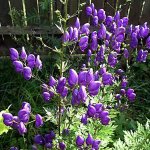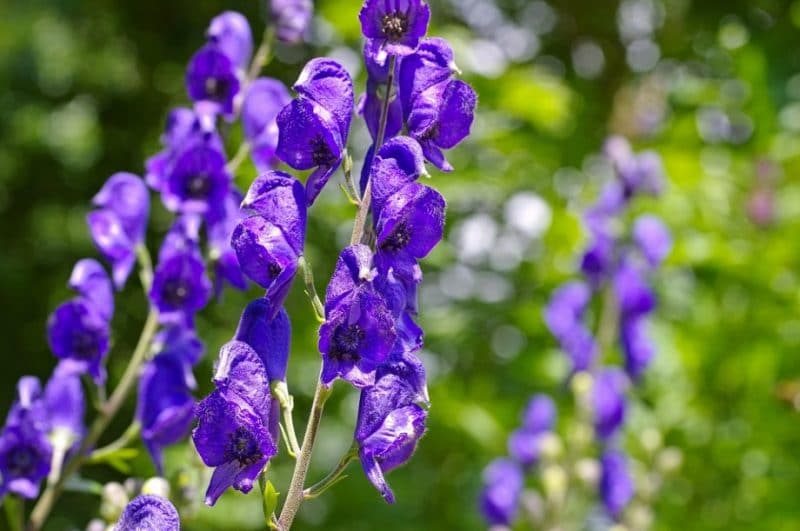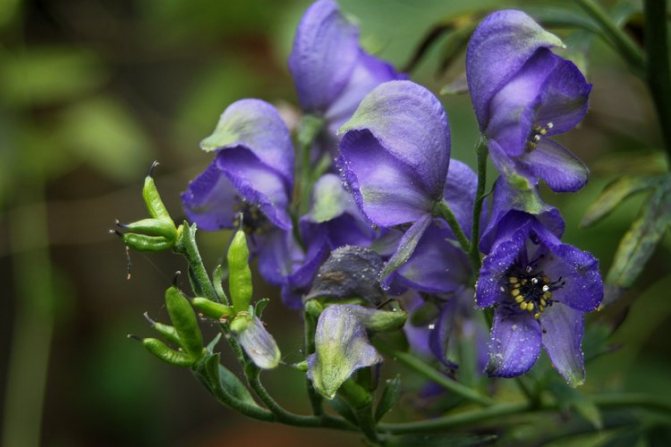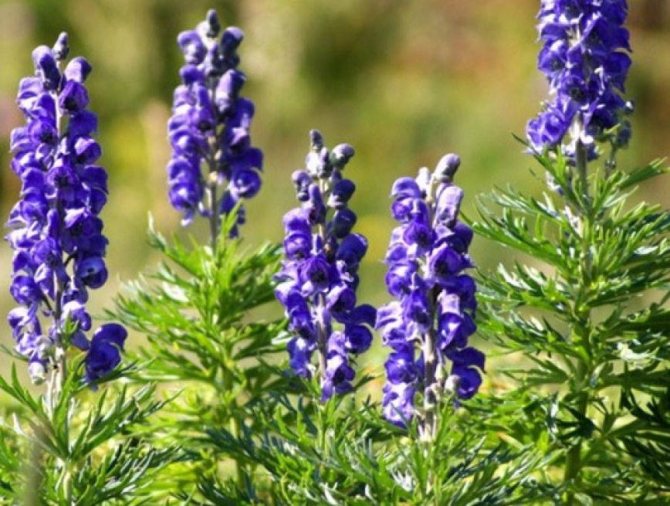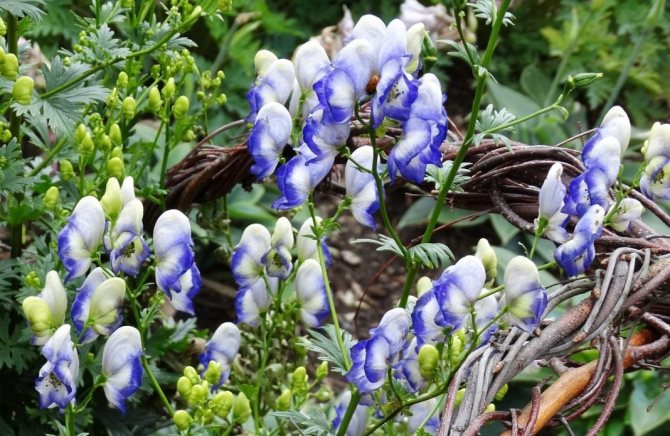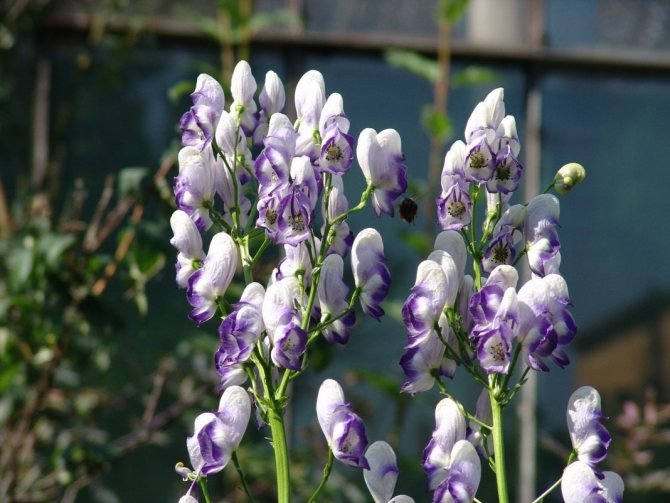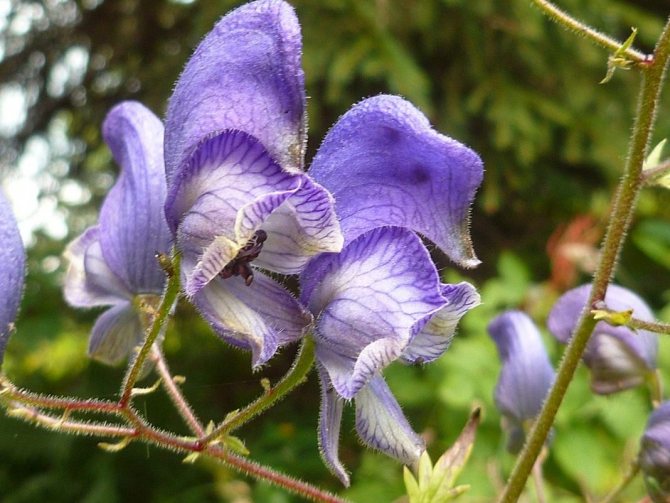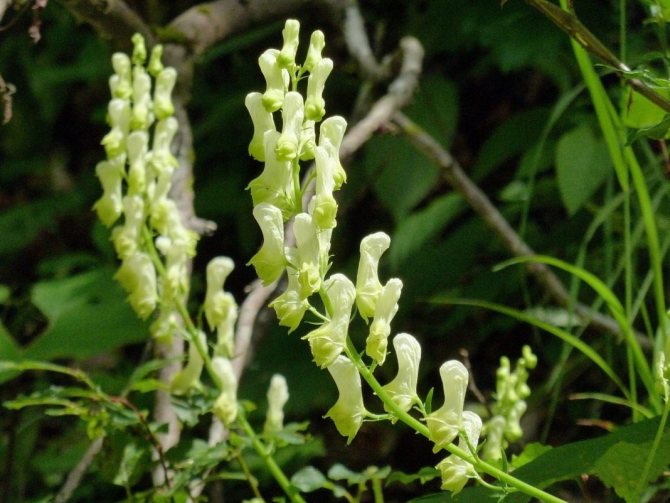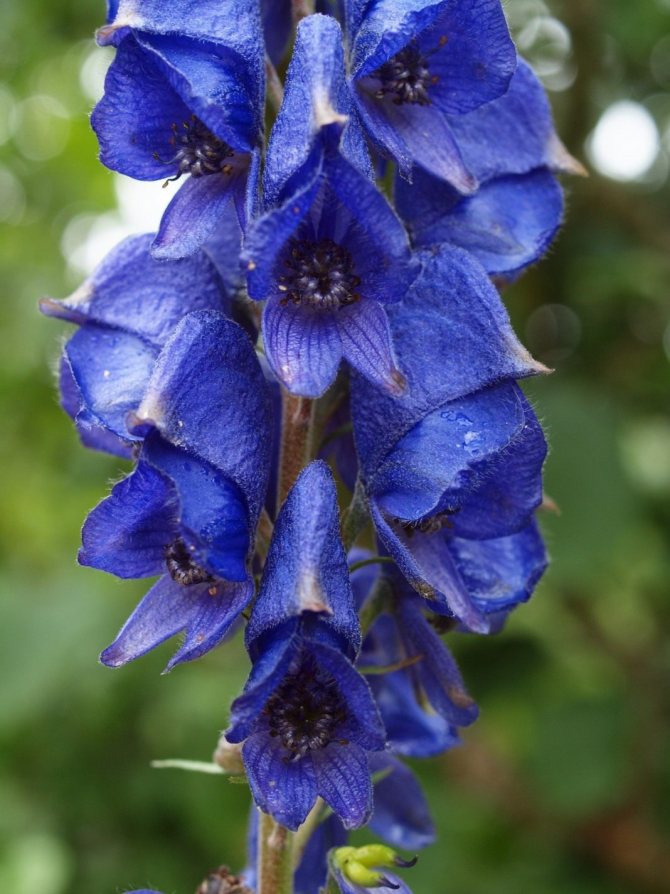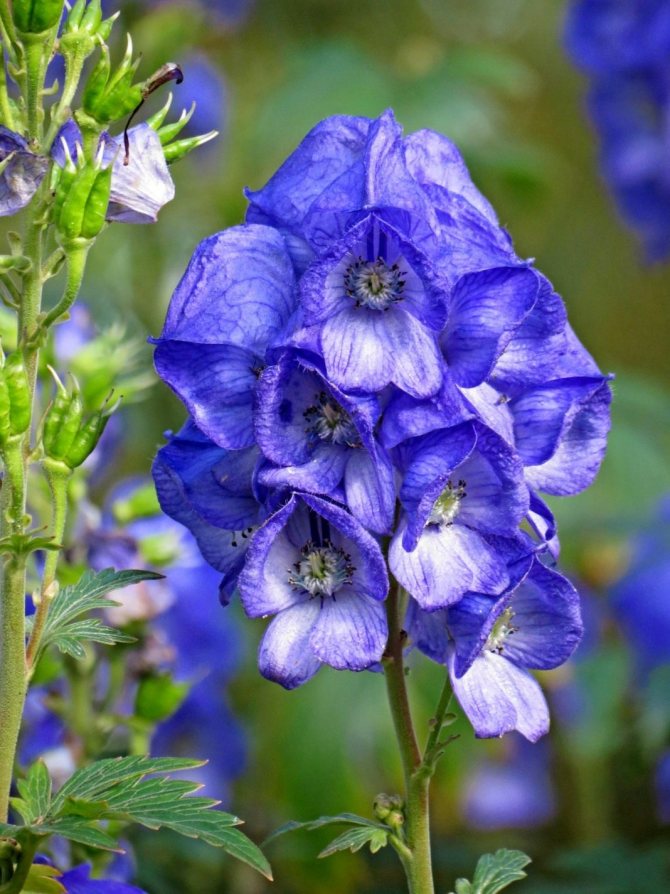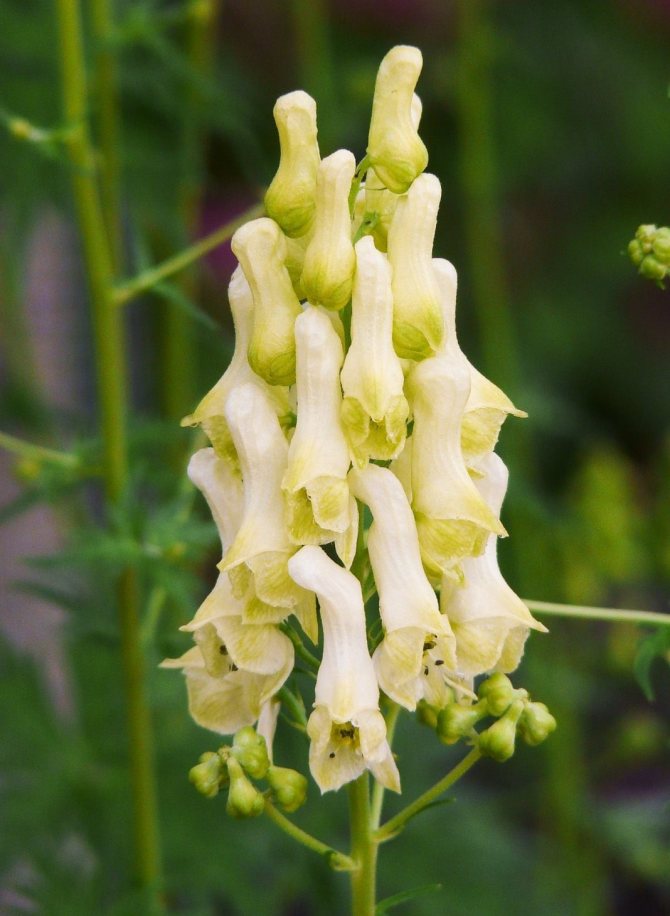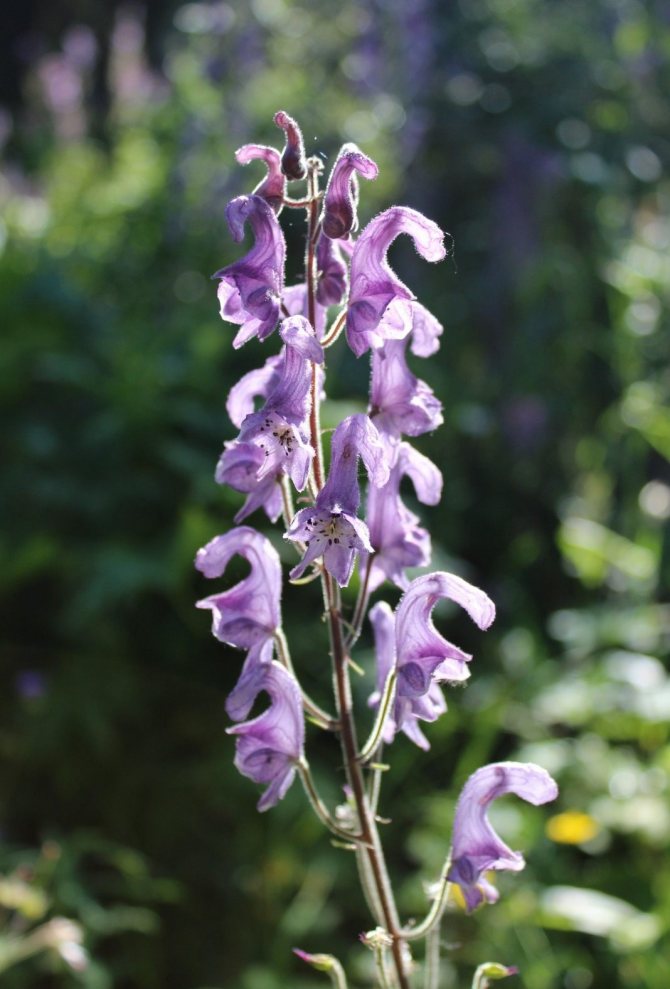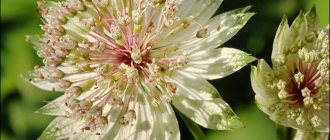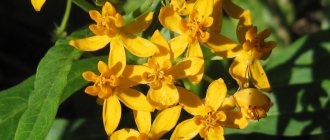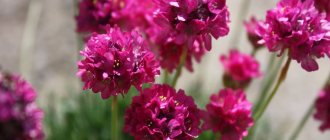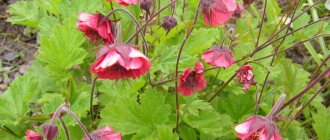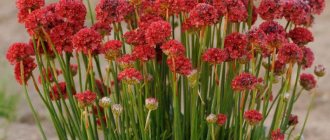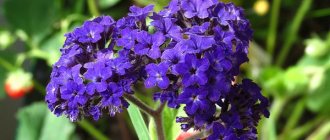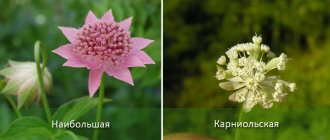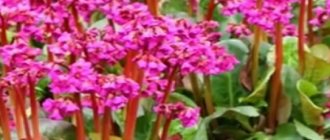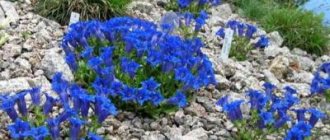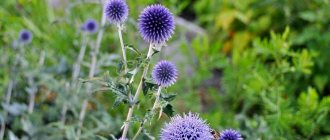Aconite is a perennial flower. This plant belongs to buttercups. The height of the bush is up to two meters. Has beautiful flowers. They are purple and have an unusual shape. Scientifically speaking, this form of flowers in biology is called zygomorphic. This distinguishes aconite from other buttercups. In the form of flowers, it looks more like legumes.
Description: varieties and varieties of aconite
Aconite (the second name is "fighter") is a spectacular tall plant that instantly attracts attention in a flower garden in the open ground with the unusual shapes of its inflorescences: a warrior's helmet is guessed in their outlines. It is believed that the flower itself symbolizes cold, poison and crime.
Attention! Aconite is a poisonous plant. Fresh tubers give off a horseradish smell and look like celery. Eating them in food is extremely dangerous: three or four pieces are enough for severe poisoning of the body.
The height of the stems of aconite reaches 50-150 cm, as a rule, they are straight, but there are varieties with winding or curly stems up to 400 cm. The flowering period of aconite is the entire summer and autumn season until October. The inflorescences of the most common wrestler varieties are colored in various shades of purple and blue, but there are types of pink, pure white, bright yellow and even purple shades.
16 excellent varieties of plums for the Moscow region
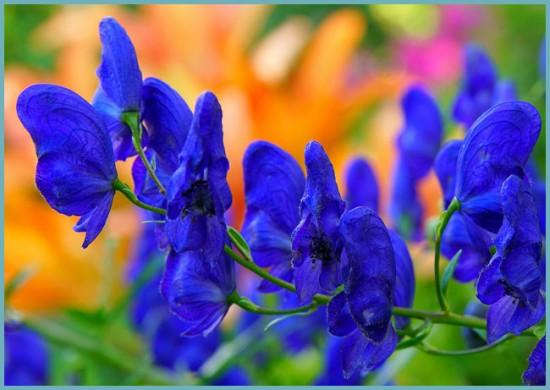
Aconite (wrestler) grows almost throughout Europe, Asia, North America, is found in forests, on the shores of lakes, rivers, near swamps. There are several dozen varieties and varieties of aconite, the name of many of them is directly related to the area: there is a Baikal wrestler, a Karakol wrestler, an Altai wrestler.
Experienced landscape designers and gardeners recommend the hood wrestler for growing in the open field (the shape of the flower resembles a monk's hood - hood). Plant height is about a meter, inflorescences are blue and purple tones, flowering period lasts at least 4-5 weeks.
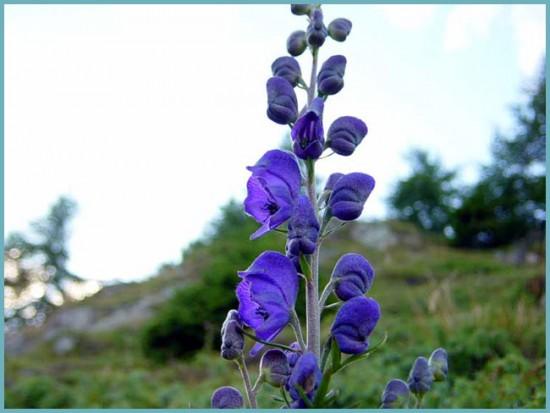

There are several subspecies of nodule aconite:
- nodule wrestler compact - blooms in late June - first half of July, inflorescences are pale lilac or grayish-white, height 90 cm - 1 m;
- lobelium wrestler - flowering period - July, petals of deep blue or bluish-blue shades;
- aconite Glaceraise - inflorescences of a white tone;
- aconite klobuchkovy pyramidal - reaches 1.5 m, the inflorescences are rather large, saturated purple-blue hue, blooms in the second half of summer;
- Aconite nodule Tavrika is a low-growing variety of Aconite (up to 60 cm high), flower baskets can be violet-blue, violet-blue with a white center.
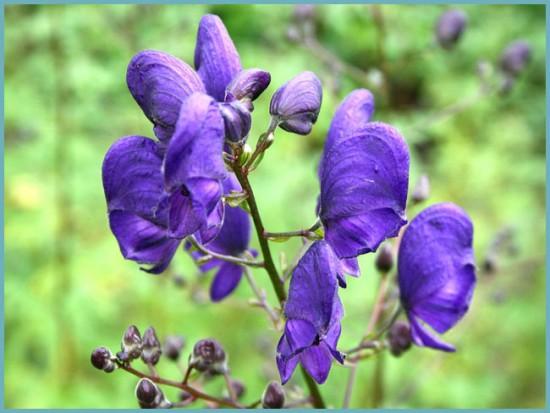

Aconite two-color looks spectacular in flower beds - inflorescences of a white tone with a wide violet-blue edging. Also, aconite motley blue-nosed is quite popular - the height of the plant is about 2 meters, the inflorescences are large, blue or white with a blue edge or snow-white. This type of aconite blooms for about 3 months: from mid-summer to mid-autumn.
Aconite: photo
Planting a plant
Aconite is a rather unpretentious plant to care for; any cultivated soil, except for sandy and stony soil, is perfect for planting and growing it in the open field. Also, the wrestler does not like damp, oversaturated soil. In autumn, with prolonged rains, good drainage of the area under the aconite should be ensured, since waterlogging of the flower adversely affects its root and leaf systems, leading to the death of the plant.
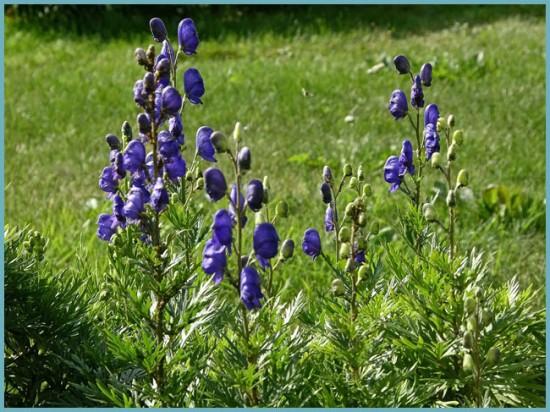

Aconite (wrestler) tolerates shade and partial shade well, so it is a suitable candidate for planting under spreading trees. Aconite itself, planting and caring for it, does not require much effort, but, like every plant, it needs the attention of a gardener.
How and when to plant white-mouth aconite
If the site is damp, then drainage must be introduced into the planting pit. It can be broken brick, expanded clay. Some gardeners use Styrofoam pieces. And in the planting soil, we will add a litter from a coniferous forest, which contains fallen needles and half-decayed pieces of pine or spruce bark. You can add some sand or vermiculite.
Something from organic matter is obligatory: compost, vermicompost, humus. Or apply a long-acting fertilizer. For example, "Bazakot".
Mix the prepared soil, fall asleep in the pit, spill it. When he has settled down, we proceed to planting. The root collar can be slightly deepened. Literally by 1–2 cm. Water again so that the new earth squeezes the roots more tightly.
We mulch on top with needles or high-moor peat. We need high moor peat. Pay attention to this. Mulch will allow you to retain moisture, preventing the earthen coma from drying out, and excess water will go through the drainage, which we put at the bottom of the planting pit.
These landing conditions will allow the wrestler to settle down with minimal stress.
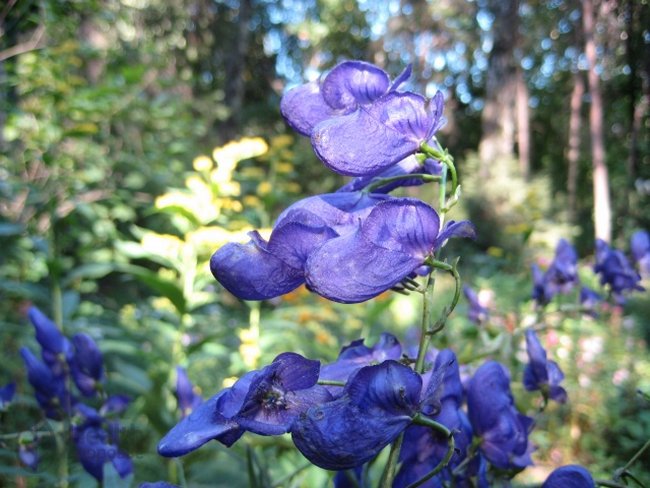

Fertilizing and feeding aconite
Aconite has been growing in one place for many years and therefore needs feeding and fertilization. It responds well to mineral fertilizers, organics are excellent for caring for aconite. In the spring, it is recommended to put a small dose of compost under each bush, which will add brightness to the flowers during the flowering period. You can apply fertilizers and fertilizing for aconite once a season, at the beginning of flowering, the result is visible almost immediately, the flower will sparkle with bright colors.
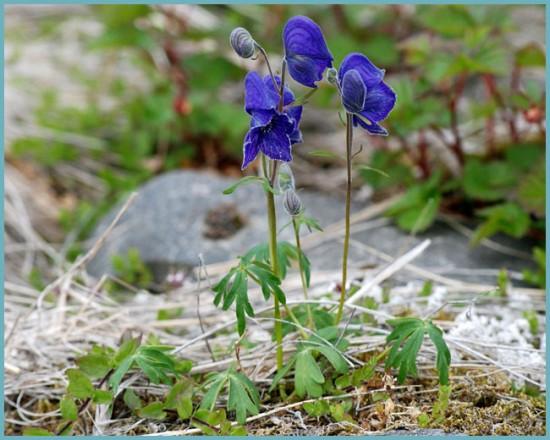

Garden wrestler, Aconite kammarum, Aconite two-color, Aconite Stork
hybrid of variegated and napellus aconites (Aconitum variegatum x A. napellus)
in some years it is strongly affected by powdery mildew, aphids
in dry periods it needs watering
responds well to fertilizing with mineral fertilizers and composting
from mid June to August
purple or white with purple edging, with a rounded-vaulted helmet with a short, curved nose
large apical brushes, branched in the lower part
alternate, heart-shaped-rounded in outline, finger-dissected into 7 large-toothed rhombic lobes, on long petioles
multi-seeded leaflets, 3-5, with purple columns
plant with upright leafy stems
has oblong tubers with numerous roots
Plant propagation
Aconite can be propagated in several ways.
Seed method of reproduction of aconite. Quite a laborious method that requires certain skills. The seeds of the wrestler need stratification (that is, it is necessary to create conditions for a change in temperature and humidity to stimulate their growth). To obtain this effect, seeds are sown in the ground before winter or at home in a container with earth they are placed in a cold place (refrigerator, cellar, taken out to the balcony). In April, the seeds must be transferred to a warm place for germination. Plant seedlings in the phase of two true leaves dive into separate containers (most conveniently plastic or peat cups).Seedlings of aconite are planted in a permanent place in August, the distance between plants is about 25 cm. Flowering should be expected no earlier than after 2-3 seasons.
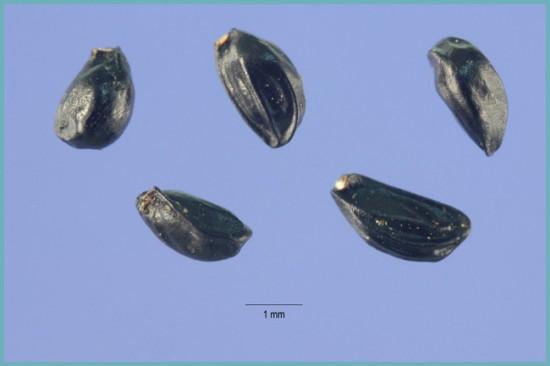

Division of the bush. It is recommended to divide the aconite bush once every four years in the spring. With a sharp spatula, separate the part together with the rhizome and transplant to a new place. Prune the plant so that each young shoot has three buds. The root collar of the plant should be dug in with soil for 2-3 cm. The transplanted culture should be watered abundantly.
Reproduction by tubers. In the first decade of autumn, aconite can be planted with tubers, 2-3 pieces are placed in one hole and added dropwise.
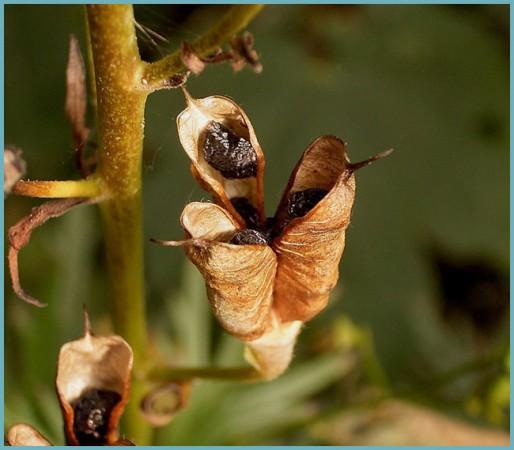

Propagation by cuttings. Green shoots must be cut in May and transplanted into a prepared place, placed in a greenhouse (covered with foil, agrofibre). After the formation of the plant, it is transplanted to a permanent place.
Agrotechnics of growing aconite: secrets and nuances of care
Caring for aconite is not difficult, the main thing is to give the plant maximum attention and care. Only then will the aconite bush delight you with its bright and lush flowering. For the full growth of aconite, it is important to water the plant on time, loosen and mulch the soil, apply fertilizers and prepare for winter.
Watering aconite
Aconite is a fairly drought-resistant plant, it needs regular and moderate watering. However, in the driest summer time, it is better to increase the number of watering so that aconite will delight you with beautiful and large flowers.
Loosening and weeding of aconite
Periodically, the soil around the aconite must be weeded out, removing all weeds. Loosen the soil very carefully so as not to damage the root system. This is necessary to saturate the soil with oxygen. To keep less weeds around the aconite, add mulch regularly. It will also help slow the evaporation of liquid from the soil.
Top dressing of aconite
If you planted aconite according to all the rules and added humus when planting, then at first the plant does not need fertilizer. However, very quickly, the long roots of aconite will take all the nutrients from the soil. Every spring, you can add a little humus under each bush, and mineral fertilizer before flowering. One top dressing per season is the optimal rate for a given crop.
Fight against diseases and pests of aconite
Diseases:
- Powdery mildew. This disease most often affects aconite. This can be caused by over-application of nitrogen fertilizers or inappropriate irrigation regimes. To cope with this disease, it is necessary to remove all damaged leaves and spray all the bushes with fungicides.
Pests:
- Aphids, spiderweb flares. These pests very often affect aconite. To combat them, you can use special insecticide preparations or take a solution of onion peel.
- Rape flower beetle. To prevent this pest from ruining the aconite bushes, it is important to regularly loosen the soil. This is how you fight the flower beetle at the pupa stage.
Diseases and pests
Aconite with improper care and cultivation in open ground, especially under fruit trees, can be affected by nematodes (gall, leaf), aphids, slugs, and other pests. Powdery mildew is also dangerous for perennials. To treat a flower from pests should be together with fruit trees with similar preparations. If the affected area of the bush is significant, it is necessary to remove the diseased plant.
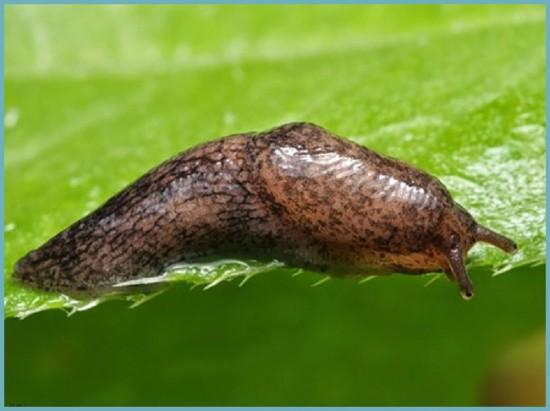

Diseases of aconite
Despite the fact that the plant is poisonous, some types of pests still affect it. It is also susceptible to the occurrence of viral and fungal diseases.
- Powdery mildew - it manifests itself in the appearance of a white bloom on the leaves and trunk of the plant. If its development is not stopped in time, then aconite will die.You can get rid of the ailment of fungal etiology by removing the damaged parts of the wrestler, replacing the top layer of soil under the plant, as well as treating aconite with the fungicide Vitaros or Fundazol. Ring mosaic - this disease looks like brown, gray and yellow spots on the leaf plates. The carrier of the disease is aphids. You can overcome the disease that has appeared by removing the infected parts of the plant.
- Viral greening - the disease manifests itself in the deformation and change in the shade of the inflorescences of the wrestler. Unfortunately, it is impossible to get rid of it, so when such a disease appears, you will have to get rid of the plant.
Aconite in landscape design
Aconite is great for planting in open ground for the formation of landscape design. The flower is effective both in single plantings (made in the form of curtains) and in group - on lawns, flower beds, in mixborders.
The use of aconite as a background for low-growing plants looks interesting. Curly varieties decorate gazebos, decorate the outer walls of houses. A tall perennial is suitable as a kind of screen for closing sheds, various heaps, and other outbuildings. The bright saturated color of aconite will successfully emphasize the beauty of the garden or summer cottage in the photo.
Try to plant aconite in your flower garden, experiment with its different varieties (tall, short, curly), colors, provide conditions for its growth and the plant will give you joy with its colors for several years.
Aconite: combination with other plants
Aconite (wrestler) looks spectacular in combination with many other plants, as partners for him are recommended:
- pion;
- delphinium;
- astilba;
- day-lily;
- rudbeckia;
- iris.
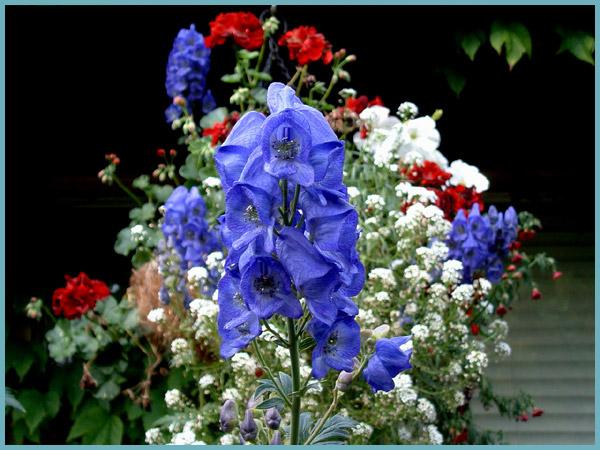

Aconite in a flower bed
Growing aconite: video
Aconite is an amazing plant. His second name is wrestler. This is very symbolic, because the plant has long been used to fight dangerous diseases, including cancer.
Aconite is a perennial flower. This plant belongs to buttercups. The height of the bush is up to two meters. Has beautiful flowers. They are purple and have an unusual shape. Scientifically speaking, this form of flowers in biology is called zygomorphic. This distinguishes aconite from other buttercups. In the form of flowers, it looks more like legumes.
Aconite: benefit and harm
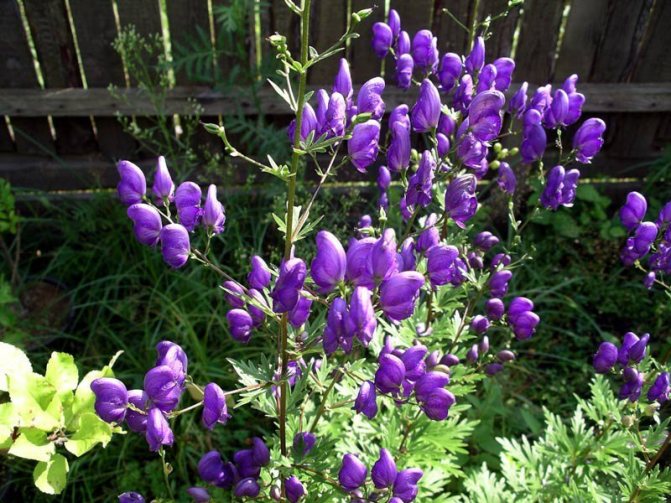

Many people do not even suspect that the pretty flower that is found in yards, meadows and along river banks is poisonous. All vegetative organs of the plant contain alkaloids (poisons) and organic acids. This feature was already known in antiquity. So, in Ancient Greece and China spears and arrows were rubbed with flower leaves when hunting large animals. But much more terrible was the history of poisoning by the "murderous blue buttercup." It was this herb that was used by a certain lady Locusta, who lived in Rome in the 1st century AD. e. With her help, many people went to the next world, including the emperor Claudius and his son Britannica.
But not everything is so scary. In the 17th century, the herb king became known as a medicinal flower. The doctor of medicine and the author of numerous medical works Anton von Stork (in some sources - Sterk), who was studying the beneficial properties of poisonous plants, drew attention to him. For merits in the medical field, the wrestler began to be called Storck Aconite.
Today, both official and traditional medicine is used by the wrestler for the production of various medicinal products. It has the following properties:
- anti-inflammatory;
- antiseptic;
- antispasmodic and others.
But it is worth remembering that any medicine based on aconite should be taken with the permission and under the supervision of a doctor.
Description of the plant
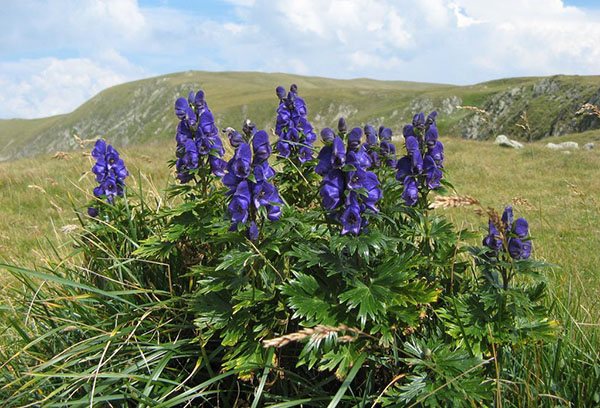

Aconite is a herb for outdoor use. The genus of the plant is very rich - about 300 species.Grows in Europe, Asia, North America. These are herbaceous perennials. The root system is in the form of tubers or rhizomes. Stems are erect. Winding and curly are less common. The height of erect - up to 2 m, curly - up to 4 m.
Rhizomes are oblong, ovoid (length - up to 5 cm, width - up to 2 cm). They grow in soil at a depth of 5 to 30 cm. The plant has finger-split, lobed or dissected foliage. The color is dark green. The location is next. Wherever aconite grows, it has gained popularity.
The flower shape is irregular. The color is usually purple. Less often - yellow, white, variegated. There are 5 sepals in the corolla. The top has a characteristic helmet shape. It covers two petals that have become nectaries. The inflorescence can be simple or complex, racemose (length - up to 50 cm). Flowering time is July-September. The fruit is the flyer. It is polyspermous, has teeth, arched or straight. The seeds of the plant are small, brown, gray or black. Their germination can last up to one and a half years.
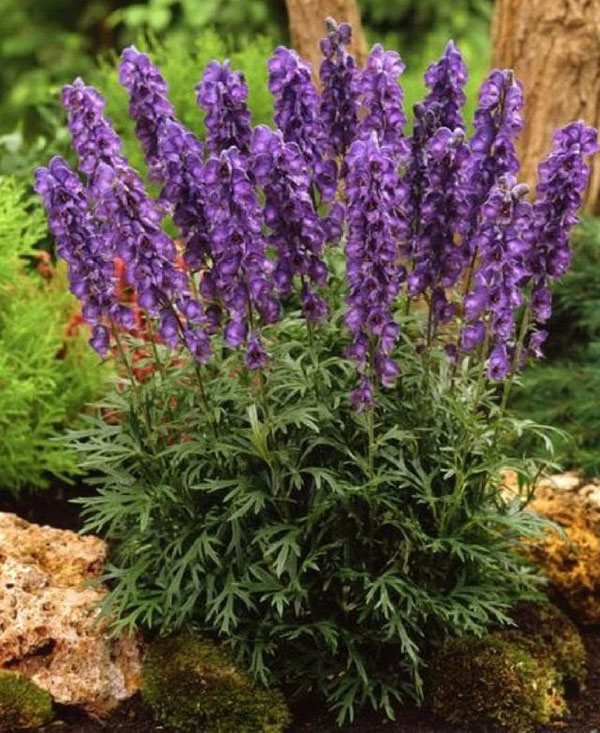

Aconite, whose flower photos are very attractive and varied, has become in demand among gardeners. The most popular form is nodular aconite (blue). This species is variable. That is why a lot of confusion is created in the names.
Everything in aconite is completely poisonous, even pollen.
The natural growing area is the northern hemisphere. Now botany has recorded about 300 of its species. There are 75 species found in Russia. Most of the varieties are fairly widespread. The most suitable soil is meadows in highlands, roadsides around dirt roads, river banks.
Meet: aconite, he is a fighter, he is the king of the grass
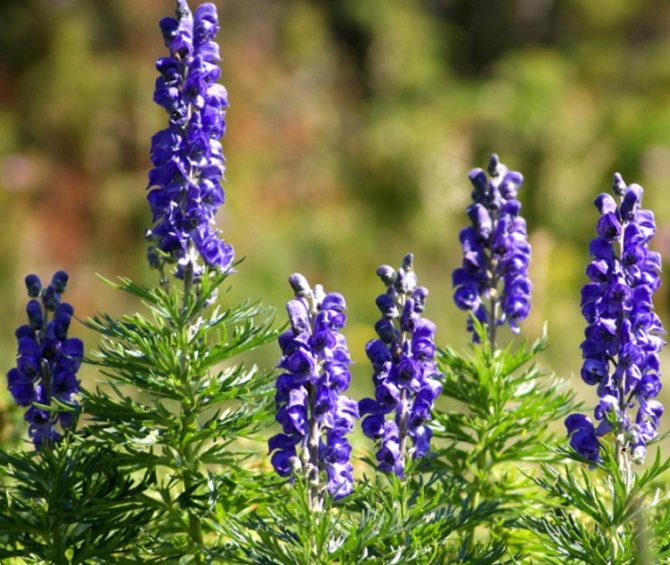

Aconite is a perennial herb that is grown outdoors. It belongs to the buttercup family and is remarkable for the toxicity of all its parts from flowers to root. The plant has been known since antiquity. Legends about the appearance of the name of the flower have also survived. The ancient Greek Hercules helped in this matter, who brought the three-headed dog Cerberus to the surface of the earth from the kingdom of the dead. The animal, frightened by the bright light, flew into a rage. Poisonous saliva flowed from his mouth. And where these drops fell, tall beautiful plants appeared, saturated with poison. All this took place near the city of Akoni. This is how "aconite" appeared.
In botany, the plant is also called a fighter, and for its toxicity and use in folk medicine, the flower is colloquially called the king-grass, shoes, blue eyes, dog death, wolf, black root and others.
Aconite is poisonous! This must be remembered when growing a flower on your site. They take care of the plant with gloves and do not allow children and pets to visit it.
More than 300 types of aconite are known in botany, most of which have common features:
- Root... It can be tuberous or filamentous, accreted into a flat taproot. The underground part of the pharmacy aconite has a bright pronounced smell, so it can be confused with horseradish or celery.
- Stems... In most species of the wrestler, the shoots are erect, ending in inflorescences up to 1.5 meters high. But there are also some varieties with climbing stems, the length of which reaches 4 meters.
- Leaves... Lobed or finger-split openwork. Larger leaves are located on the lower part of the shoots. Closer to the flowers, they shrink.
- Flowers... Collected in racemose or paniculate inflorescences. Color - various shades of blue, purple, less often white, pink, yellow. Flowers appear from late May to October, depending on the particular cultivar.
- Fruit... Appear in place of flowers. There are many small seeds inside.
Among the representatives of the genus, there are plants that prefer different places of "residence". In the wild, the wrestler is common in Europe, Asia, America. The flower grows in the Far East and Siberia.Thus, the northern aconite chooses the cold weather of the forest-tundra and forest-steppe zone of the European part of Russia. It is also found in the mountains above the forest belt, in alpine meadows. White-mouthed aconite grows in the Altai mountains at an altitude of 2000–3000 m above sea level, climbing aconite can be seen in forests, on the outskirts of bogs, on dry meadows of Western and Eastern Siberia, in the Far East.
Due to its resilience and unpretentiousness to the surrounding conditions, aconite can be found in many parts of Russia. Such a modest disposition was appreciated by gardeners, so the plant is successfully grown on their plots as one of the herbaceous plants for open ground.
Curious facts
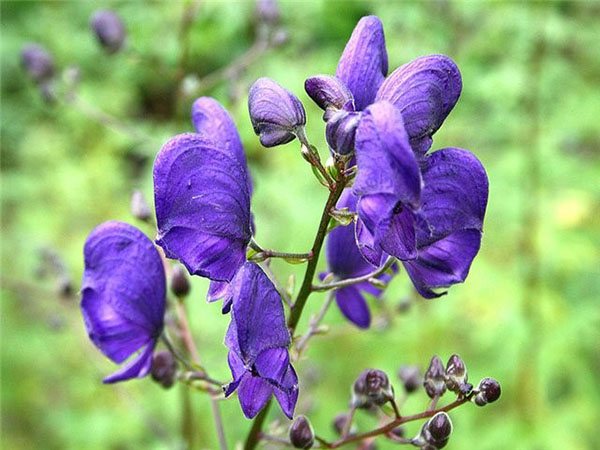

Aconite is a plant with a rich history. Many legends and myths have been invented about him. He is mentioned in ancient legends and epics of the Scandinavians. This mysterious plant is found in a huge number of recipes for witchcraft drinks.
Here are just a few interesting facts:
- The plant is mentioned even in the eleventh feat of the famous Hercules. According to the myth, it grew from the place where a drop of the poisonous saliva of the dog Cerberus fell. This inhabitant of hell was horrified when Hercules brought him to earth.
- This name came from the Scandinavians. In Scandinavian myths, the wrestler grew up where the god Thor died. He defeated a terrible poisonous snake, but died from numerous bites.
- In ancient Greece, the plant was often used as a poison. They killed those who were sentenced to death for crimes. Thus began the sad fame of Aconite.
- Plutarch mentions that the soldiers of Mark Antony were poisoned with the help of aconite. The state of the poisoned is described in detail. They wandered for a long time without a goal, fell into a deep unconsciousness, as if they were constantly looking for something. Then they vomited with bile and eventually died. The death was painful and long.
- The ancients cultivated aconite as an ornamental plant. In antiquity, it could be easily found in city gardens. Even around the palace of the emperor, lush lilac bushes were planted. The year 117 was a turning point. Cases of poisoning have become more frequent. Emperor Trajan began to associate the mass death of his servants with the aconite bushes. From that year on, the plant was banned as an ornamental plant.
- In antiquity, the inhabitants of the island of Chios with the help of aconite poison got rid of the sick, the elderly and the infirm. According to a cruel custom, a person had to voluntarily drink prepared poison in order to get to another world.
- East Indians have long used a poison called bik. They carefully grease the tips of their arrows and spears with it. This helps to significantly increase the efficiency of hunting, especially for large animals. The Digaroa tribes still use pounded aconite root for this.
- In the dark times of the Inquisition, if aconite was found in a dwelling, a woman could be accused of witchcraft. For this she was burned.
Application in medicine
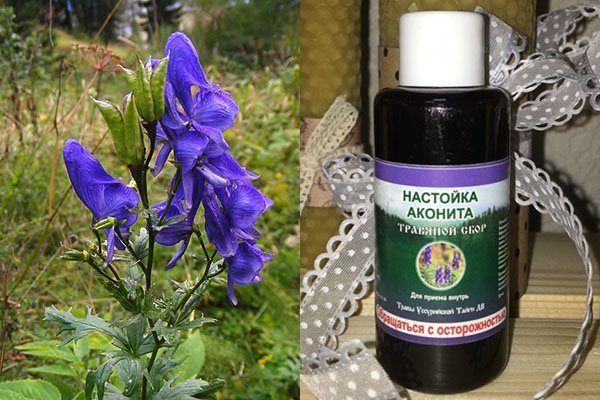

It is difficult to find a disease that cannot be treated with aconite. It is not for nothing that the wise people of Tibet call him nothing but the "king of medicine." It was here that it was first used as a medicinal plant. He is mentioned in the work "The Four Books". Aconite was used to fight against tumors and infections, pneumonia, anthrax. In Russia, it was often used externally to relieve pain.
Pliny the Elder mentions this bush as a remedy for the treatment of eyes. There are many examples of how glaucoma and blindness were cured with it. At the same time, the author calls it nothing more than “vegetable arsenic”. Its toxicity is emphasized.
Vienna physician Anton Sterk has researched for years how aconite the fighter cures cancer. He has documented cases of recovery. Sterk went to great lengths to determine the safe and most effective dose of the drug derived from this plant.
In 1838, the Sovremennik edition published a letter that V. Dal wrote to his friend doctor Odoevsky.The message told about the case of a peasant cured by aconite from severe pneumonia. When Dahl's own son fell ill with croup, the scientist also treated him with this plant.
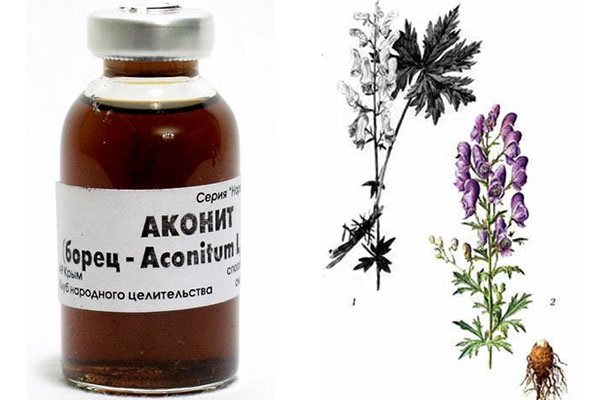

Among Soviet doctors, the first to draw attention to aconite was doctor Zakurtseva. She researched it thoroughly and developed her own cancer treatment method.
Since 1946, the following types of aconite have been officially recorded in the Soviet Pharmacopoeia:
Now the plant has no medicinal status. Despite this, the pale-mouthed species is used for the industrial production of allapinin. This drug is used for arrhythmias. The Dzungarian species is traditionally used in herbal medicine, as one of the complex of drugs in the treatment of cancer.
Do not use aconite tincture without consulting a homeopath! It is important to choose the right dosage.
The use of aconite in medicine
It is difficult to find a disease that cannot be treated with aconite. It is not for nothing that the wise people of Tibet call him nothing but the "king of medicine." It was here that it was first used as a medicinal plant. He is mentioned in the work "The Four Books". Aconite was used to fight against tumors and infections, pneumonia, anthrax. In Russia, it was often used externally to relieve pain. Pliny the Elder mentions this bush as a remedy for the treatment of eyes. There are many examples of how glaucoma and blindness were cured with it. At the same time, the author calls it nothing but "vegetable arsenic". Its toxicity is emphasized.
Vienna physician Anton Sterk has researched for years how aconite the fighter cures cancer. He has documented cases of recovery. Sterk went to great lengths to determine the safe and most effective dose of the drug derived from this plant. In 1838, the Sovremennik edition published a letter that V. Dal wrote to his friend the doctor Odoevsky. The message told about the case of a peasant cured by aconite from severe pneumonia. When Dahl's own son fell ill with croup, the scientist also treated him with this plant.
Introduced species
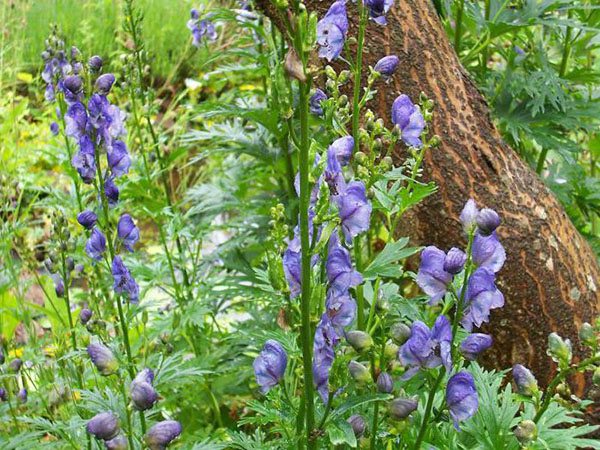

This attractive shrub is often used in landscaping. Western florists especially love him. A huge number of decorative forms have been brought out. Wolf aconite is very popular. The plant has several advantages at once. Its bushes have luscious, lush leaves and bright small flowers that bloom in abundance. Ornamental species have low toxicity, and after generations they completely lose it.
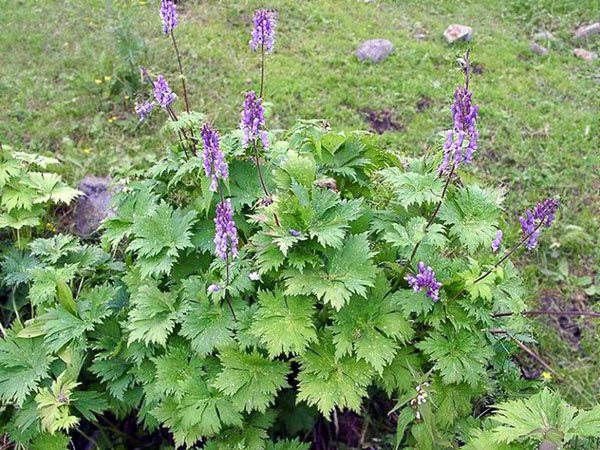

The following species are especially decorative: Aconitum variegatum, Aconitum lycoctonum, Aconitum napellus, Aconitum stoerckeanum and Aconitum cammarum. These are small shrubs (up to 2 m). Their feature is lush inflorescences that resemble pyramids in shape. The flowers are very bright. There are yellow, purple, blue-white and even blue.
To emphasize the unusual shade of aconite flowers, plant short plants with contrasting shades (yellow, orange, red) next to it. Gardeners are very fond of Dzhungarian aconite for its unpretentiousness. Insects fly around them.
In summer cottages and in nature, the following types are common:
- Aconite paniculata. Homeland - the south of Europe. It has a beautiful branched stem. They are distinguished by a decorative brush of flowers on long pedicels. The seeds have one wing.
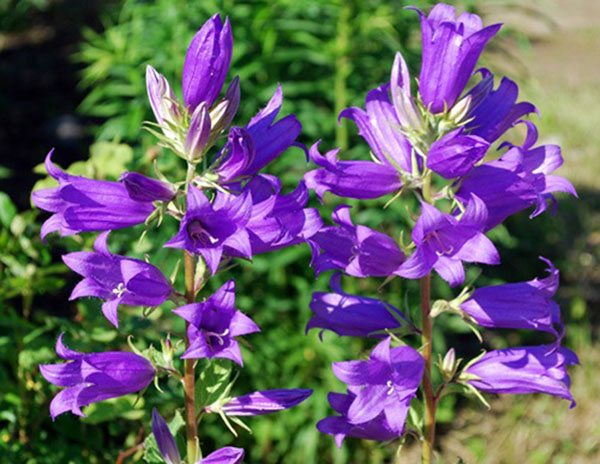

- Variegated aconite. Distributed in the Carpathians. The signs are the same as in the previous species, but less pronounced.
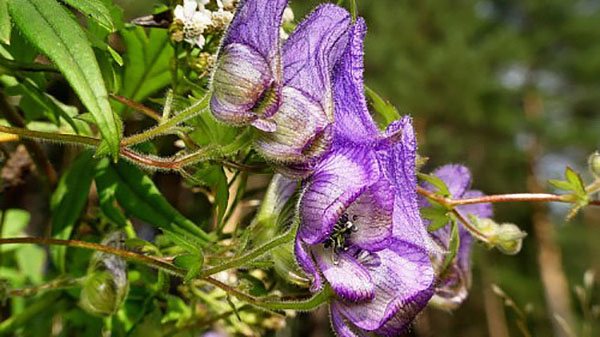

- Aconite two-color kammarum or aconite Sterka. It is a graceful hybrid of blue and variegated species. It favorably combines the signs of crossed parents. But the flower is colored more interestingly. It is two-tone. It is the two-tone form that has become very popular among flower growers. In the gardens you can find different varieties of it: Bicolor - has short inflorescences with white flowers, bordered with purple; Grandiflorum Album (Grandiflorum Album) - is distinguished by perfectly white flowers, collected in luxurious brushes; Pink Sensation ”(‘ Pink Sensation) - as the name implies, has pink inflorescences.
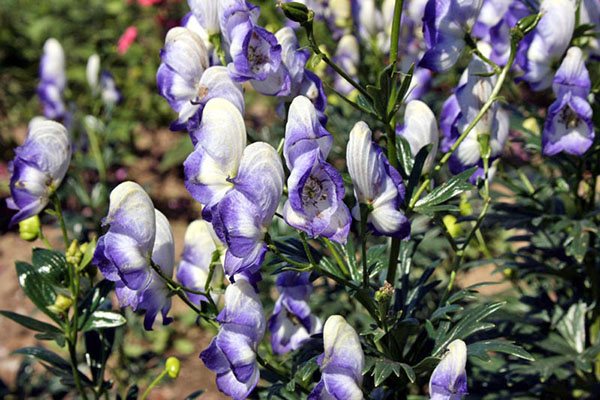

- Aconite nodule is prized for its bright blue flowers. They are very decorative. The blue shade is rarely found in nature, because this type has become very popular with gardeners.
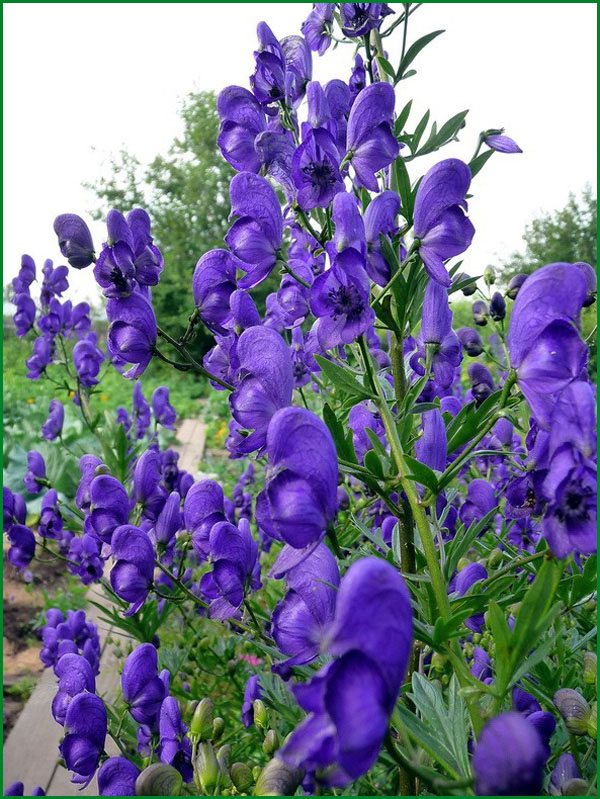

- Aconite Karmikhel is also often seen in gardens.Its flowers are distinguished by a pleasant blue-violet hue. The panicles are medium, rather decorative.
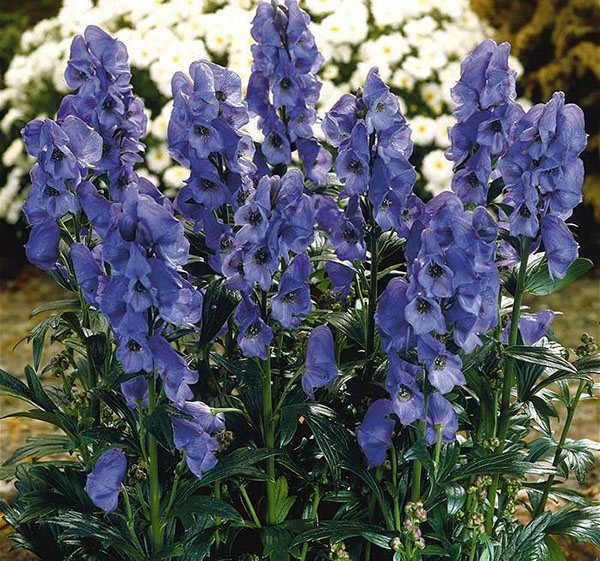

- Aconite curly. A very interesting shape. It has a curly stem that can grow up to 4 meters.
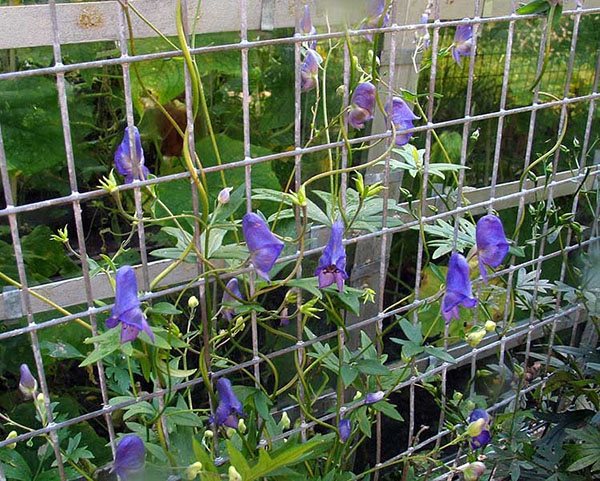

Preparation before planting aconite in open ground
Aconite is a rather unpretentious plant, however, in order to properly grow a crop, it is important to carefully prepare so that the plant turns out to be strong and beautifully blooming. First of all, take care of choosing the right variety and buying a healthy seedling. If you want to grow a plant from scratch, sow the seeds in time for a strong seedling before planting.
Stage 1. Selection of variety and seedling of aconite
- Aconite can be of different heights, so select a specific variety for a pre-planned planting site.
- You can pick up varieties of different colors, which will create a very beautiful garden composition. In addition to blue and purple, the standard colors of aconite, breeders have now bred a large number of varieties with white and yellow inflorescences.
- If you do not want to independently grow seedlings or seedlings of aconite, ready-made seedlings can be purchased at specialized garden centers and nurseries that are professionally engaged in plant breeding.
- Before buying, you can ask consultants about the growing conditions for a particular aconite variety.
- When you buy in specialized stores, you get a seedling that is already adapted to the conditions of your climate.
- Inspect the entire seedling carefully before purchasing. It should be free from damage, signs of disease and the presence of pests.
Stage 2. Choosing a site for planting aconite
- The choice of a place in the open field for planting aconite is the most important stage, since this plant is very poisonous and, if ingested, can cause an attack of suffocation and paralysis.
- First of all, such a bush should grow in a place inaccessible to pets and children.
- Aconite is not picky about sunlight, so it can grow well in small shade, for example, under the crown of small garden trees or along high fences. Curly varieties can be put on the wall of the house or planted near the gazebo in the garden.
- Some aconite varieties prefer to grow in elevated areas, but most can thrive in slightly waterlogged areas.


Stage 3. Selection and preparation of soil before planting aconite in open ground
- All varieties of aconite grow well on almost any type of soil.
- Gardeners do not recommend planting this crop only on heavy rocky soils.
- This plant prefers to grow in nutritious and fertile soils. If the soil in your chosen area is very poor, it must be well fertilized before planting aconite seedlings. In this case, compost or humus is suitable.
- Do not plant aconite on clay soils, as they retain moisture, and this is detrimental to the culture. To make such a soil suitable for planting seedlings, simply add a little sand at the planting site.
- Before planting, the area of soil you have chosen must be carefully dug up, weeds removed from it and loosened.
Growing aconite


If you decide to start aconite, planting and maintenance in the open field does not require much effort. This is an unpretentious plant. Many species overwinter well.
Light-loving species - Aconitum anthora and Aconitum carmichaelii. It is better to plant them in elevated areas. Other species tolerate excess moisture.
The plant tolerates transplanting well. It is better to divide the bushes in the spring, but you can also in the fall. There should be no stems. Make the planting hole wide and deep to keep the rootstock comfortable. Before planting the plant, you need to add mineral fertilizer (15-20 g) to the hole. Deepening of the neck of the root - 1-2 cm.The distance between the bushes is 25-30 cm.
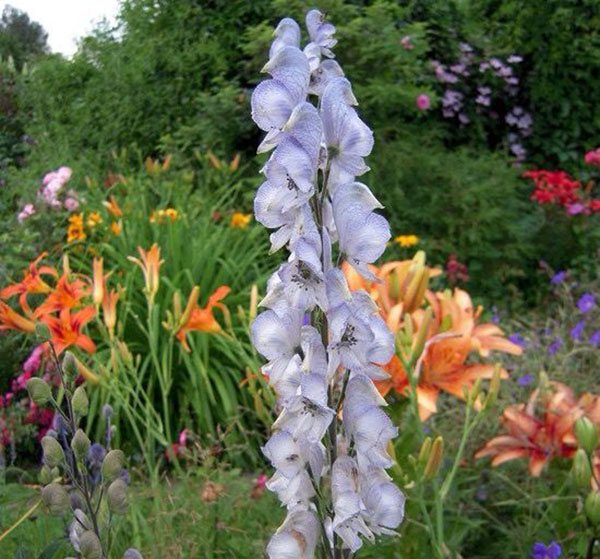

It reproduces well vegetatively, by dividing the bushes. Worse - seeds. Seed propagation does not preserve the characteristics of the variety. It is best to stratify before seeding. Flowering should be expected only for 2-3 years.
The care is as follows:
- regularly need to loosen the soil.
- feeding once every 1-2 months.
- dried inflorescences must be removed.
- if the season is dry, the plant is watered.
The plant is prone to damage by powdery mildew.
Aconite flower photo care
There is nothing difficult in caring for the king-grass. Don't give the weeds the slightest chance of survival. Loosen the soil around the plant. When a drought hits the ground, it is imperative to water. Aconite dislikes sushi. We cut off our obsolete flowers, in the standard way prolonging flowering in this way.
Once every 1-2 weeks, you can please the wolf with sour watering. To do this, citric acid should be taken about half a teaspoon (3 g) and diluted in 10 liters of water.
A couple of times a season feed your king grass with potassium sulfate 20 gr. for 10 liters of water. Try to do this at least in the fall. It will help your pet get through the winter successfully.
If the soil is alkaline on the site, but everything is fine with the rest of the plants, then for aconite you can dig in a wide ring of some inert material (make a limiter) and acidify the soil only near it. Without the fear that too low pH will interfere with neighboring flowers.
In autumn, the bushes are cut, leaving hemp 20 cm high. The remains of the bush are mulched with peat. In general, the plant tolerates winters well, but it is better to cover young bushes with spruce branches or foliage.
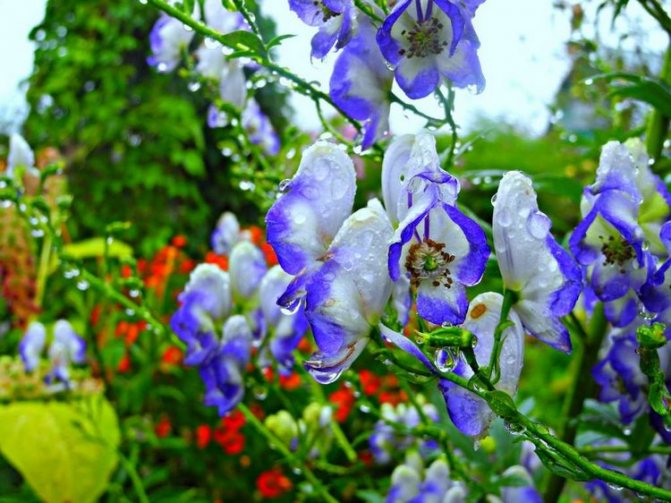

Features of the composition
In aconite, two types of alkaloids are found at once:
Their localization is the whole plant (from flower to root). Atizine are volatile alkaloids. They are not poisonous. Upon hydrolysis, it breaks down into organic acid and arucanine. The plant contains very few of them. It is atyzine alkaloids that have a beneficial effect on the heart and blood vessels.
More interesting are the acanite alkaloids. The majority of alkaloids are found in tubers and roots.
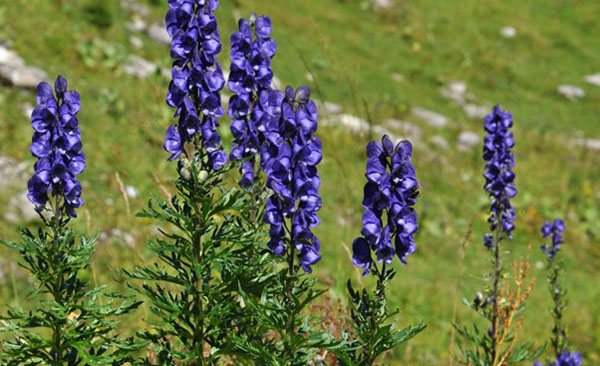

Each species has its own degree of toxicity. Also, this indicator is influenced by the type of soil, collection time. The least poison is in those plants that grow on water-flooded and swampy soil. If the plant is harvested in the fall or spring, it will be as toxic as possible.
Poisonous species contain a maximum of aconitine and its derivatives. Almost any type of plant is poisonous to humans. But the degree of their toxicity can vary greatly.
You can easily check how poisonous the plant is. It is enough to squeeze out some juice and rub your finger with it. If poison is present, itching will appear. Then the skin will begin to burn, and soon it will lose its sensitivity. This is a clear sign that the sample taken is poisonous. This effect is explained by the fact that aconitine is capable of exerting a pronounced irritating and paralyzing effect on the nerve endings.
We do not recommend experimenting with this dangerous plant. Even applying its juice to a finger is fraught with undesirable consequences. The most dangerous thing is to use grated roots.
Medicinal properties and contraindications
The alkaloids included in the plant simultaneously give it poisonous and medicinal properties.
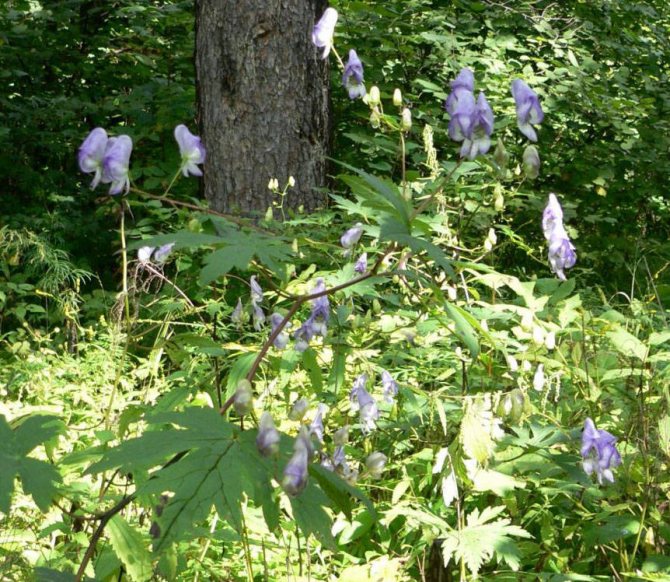

Aconitine is especially toxic, which paralyzes nerve endings.
Official medicine has proven that aconite relieves pain, has an antispasmodic and antiallergic effect, and has a positive effect on the nervous system.
Alkaloids successfully fight tumors. The Dzungarian or Issyk-Kul root wrestler is used for neuralgia and rheumatism.
How does it affect the body
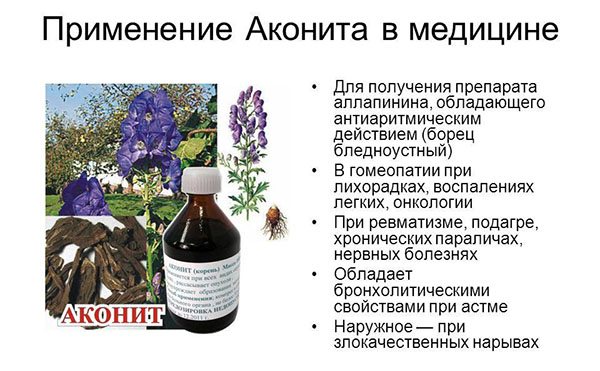

Aconite has an extremely destructive effect on the central nervous system. Its effect can be compared to the famous curare poison. If a lethal dose enters the human body, paralysis of the respiratory center rapidly develops. This leads to inevitable death.
That is why it is strictly forbidden to independently use the plant for medicinal purposes. Only an experienced physician can find a safe dose. It should be scanty. In this case, the therapeutic effect does not occur immediately. A certain amount of alkaloid must accumulate in the blood.
The therapeutic dose of aconitine helps to stabilize the heart rhythm and respiration. It activates the metabolism in cells, negatively affects all kinds of infections. It is also noticed that the growth of neoplasms slows down. If the dose is not calculated, paralysis of the heart muscle and suffocation may occur. This is inevitable doom.
If a homeopath is treating with the poison of this plant, he is extremely careful in choosing the dosage. It must be strictly individual.
Aconite tincture is used in homeopathy. After taking this agent, strongly diluted with water, increased salivation may be observed. This is a sign that the alkaloid has begun to work. When it is absorbed through the oral mucosa, it irritates the parasympathetic nerve. And the body temperature can also drop for several hours.
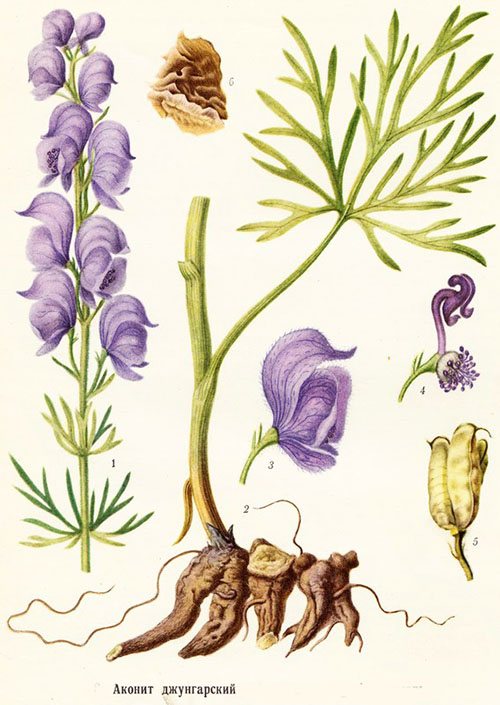

The therapeutic effect is achieved only by regular use of the alkaloid. It is important that it accumulates in the body and reaches the desired concentration. This turns on defense mechanisms, the body begins to fight.
The decoction of the plant is two times weaker than the infusion. This should be taken into account when taking a dose. With the help of tincture of Dzungarian aconite, homeopaths treat the following diseases:
- hormonal imbalance, impotence, infertility;
- prostration;
- anemia;
- the goiter is toxic;
- diabetes;
- blindness, deafness, cataracts, glaucoma;
- benign type of neoplasm;
- kidney stone disease;
- gallstone disease;
- angina pectoris, hypertension, arrhythmia;
- gastritis, ulcers, pancreatitis, cholecystitis, diarrhea, constipation, flatulence;
- asthma, pneumonia, bronchitis, pleurisy, tuberculosis;
- trigeminal neuralgia, depression, migraine, paralysis, insomnia, Parkinson's disease;
- tics, seizures, schizophrenia, psychosis;
- sexually transmitted diseases, anthrax;
- arthritis, arthrosis, gout, sciatica, fractures, dislocations, bruises, osteochondrosis, etc.
Also, the plant is used:
- as an external antiseptic (scabies, head lice);
- as an antidote (mushroom, plant poisoning);
- as a remedy against tumors.
As you can see, aconite, the photo and description of which we offered you, is a very interesting medicinal and ornamental plant.
Aconite (Aconite) or wrestler is a herbaceous perennial plant, sometimes in the form of a vine, from the Buttercup family. The plant is common in the temperate climate of Eurasia and North America. The genus includes about 300 plant species.
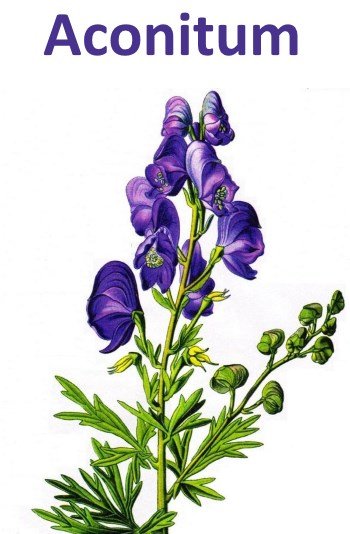

Aconite
The use of aconite for medicinal purposes
Considering that all organs of aconites contain a poisonous substance of a burning-pungent taste, it is not recommended to use plants on their own in treatment, or rather, it is prohibited. Aconitine alkaloids cause paralysis of the respiratory center, affect the central nervous system. With untimely assistance, people and animals die.
Fresh articles about garden and vegetable garden
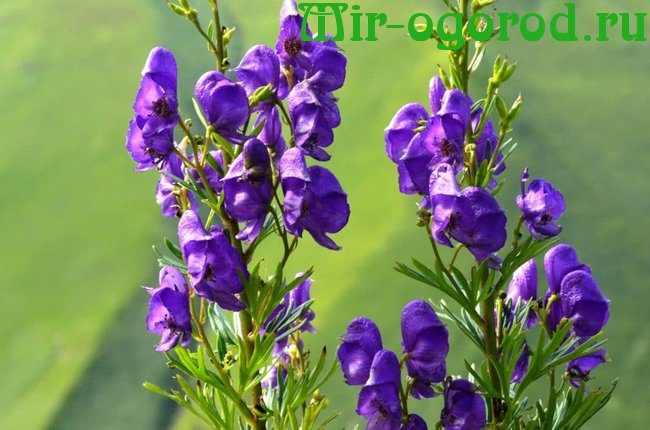

It should be noted that garden varietal forms lose their toxicity level over time, but still require careful handling. In the official pharmacopoeia, tinctures are used on the prescription of a doctor, and in Chinese medicine, a technology for the treatment of oncological diseases has been developed.
- How to store leeks in winter
- Supply ventilation in the apartment: 4 years of operation
Category: Cottage
Description
Many legends and myths are associated with the aconite plant. In Greek myths, it is said about the origin of the flower from the poisonous saliva of the dog Cerberus, which Hercules brought out of the underworld. In the Scandinavian sagas, the appearance of a flower is associated with the god Thor, who defeated a poisonous snake, but died from its bites, and a wrestler began to grow at the place of the god's death. People from ancient times knew about the mortal danger posed by a beautiful flower.All parts of the plant, including pollen and seeds, are poisonous, even the scent of aconite can cause poisoning. In warm regions, toxic substances accumulate in the plant to a greater extent than in northern latitudes.
Attention! Symptoms of aconite poisoning look like this: pressure drops sharply, temperature rises, heart rate increases, vomiting opens, a person is thirsty. If you do not see a doctor in time, seizures can begin and death can occur.
The wrestler is an erect lush bush from 30 cm in height, or a climbing vine over 200 cm in length. Leaves are bright green, palmate, dissected, often pubescent. The flowers are collected in inflorescences resembling lupine inflorescences, they are white, blue or yellow. Flowering occurs in late summer and lasts more than a month. Grown on cultivated fertile soils for many years, aconite can lose its poisonous qualities.
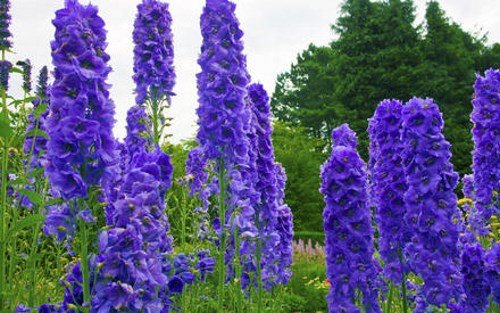

Appearance
Soil for planting
Loves loose, nutritious substrates. Black Potion prefers pH 4.6-6. These are acidic soils. In a gardening store, you can buy a litmus test and, following simple instructions, quickly determine the acidity of the soil on the site.
Some growers complain that aconite does not take root in any way. Others do not get tired of being surprised and declare that aconite grows without any care, and even actively multiplies. The point is in the acidity of the soil, the presence of nutrients, the amount of light that gets to the plant. If the last factor can fluctuate in different species, then the requirements for the first two are approximately the same.
Types and varieties
The most popular among gardeners is aconite klobuchkovy (the flower got its name due to the similarity of the shape of the flower with the monk's hood - klobuk) or blue. This is a plant that grows up to 150 cm in height. It blooms in blue from July to late summer. In addition to decorative use, it also has medicinal uses. A wrestler of this species hibernates well without shelter in our latitudes. Due to the variety of forms of napellus aconite, many varieties of the plant have been bred. For example:
- Albiflorus is a plant with white flowers;
- Carneum - aconite with beige and pink flowers;
- Eleanor is a variety with white flowers with red edging;
Site selection and soil preparation for planting aconite
Aconite grows well in sunny areas, in partial shade, and even tolerates dense shading for several hours a day. The plant is suitable for planting under large trees, near buildings, fences. Climbing species are planted only in partial shade, the bright sun can burn delicate foliage.
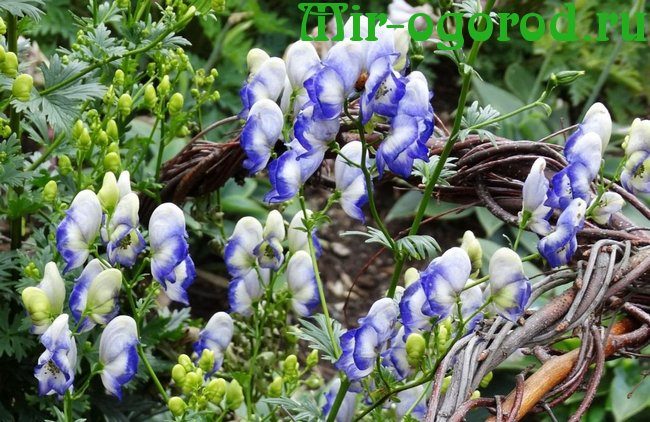

Why plant a wrestler in the garden
The beauty of a large plant with a bright and long flowering is certainly eye-catching, and many gardeners want to see aconite in their flower garden.
The wrestler looks great when planted alone or in a group with other plants. Aconite is harmoniously combined with daylilies, delphiniums, irises, peonies, astilba, large daisies. The combination of blue or purple flowers of aconite and bright yellow flowers (for example, golden balls of goldenrod) looks spectacular. Curly types of aconite decorate fences, gazebos. The advantage of plants is that the wrestler is unpretentious and grows well in our difficult climatic zone.


Plant in the garden
If you correctly select the types and varieties of aconite, then you can admire the bright "candles" of the plant throughout the season. High aconite opens the season, blooming at the end of May. In June, it is joined by woolly and white-toed aconite. In July, the oak wrestler (Antora), paniculata, opens up. August bloom in Fischer's aconite, nodule and climbing species. The combination of large bright inflorescences of aconite with openwork foliage makes it possible to plant aconite in the foreground of flower arrangements.
Attention! It should be remembered that the plant is extremely poisonous! You can only work with it with rubber gloves.If there are often children and pets on the site, it is better to refuse to plant aconite.
In addition to beauty, aconite has found application in folk medicine. Aconite-based preparations are used to treat nervous disorders and depression. Helps fighter in the treatment of rheumatism, arthritis, asthma and pleurisy. Helps with stomach ulcers, intestinal colic, parasite infestation. Outwardly, they are used to combat scabies, lice, as a wound healing agent.
Despite the obvious medicinal benefits of the plant, it should be used only after consulting a doctor, and under the strict supervision of a specialist.
Collection of recipes
How to care for aconite
The plant does not tolerate the neighborhood with weeds, so they must be constantly removed, loosening the soil. When aconite begins to bloom, it is fed with mineral or organic fertilizers. The soil is mulched with hay, peat or humus, otherwise it will dry out quickly, especially if it is hot outside. It will not be superfluous to arrange an irrigation system, which will provide constant moisture to the garden area. To maintain a pleasant appearance in the flower bed, old flowers are constantly removed, after which it is much easier for new ones to grow.
Fresh articles about garden and vegetable garden
Aconite comfortably tolerates the effects of frost. The bush is prepared for wintering as follows: the stem is significantly cut off, the rhizome is insulated with peat, covered with a 20-centimeter layer.
Do not forget that aconite contains poisons. Wear protective gloves during work, which must be washed after work. Wash your hands and face with soap and water before drinking and eating. If you have herbivores, make sure that no pieces of aconite get into their food. In folk medicine, various infusions of this plant are used. It is not recommended to make them yourself: depending on the variety and living conditions, the composition of biological substances in different plants is different. As a result, you may get a completely different drug that you wanted to prepare. For treatment, it is better to purchase medicines at a pharmacy.
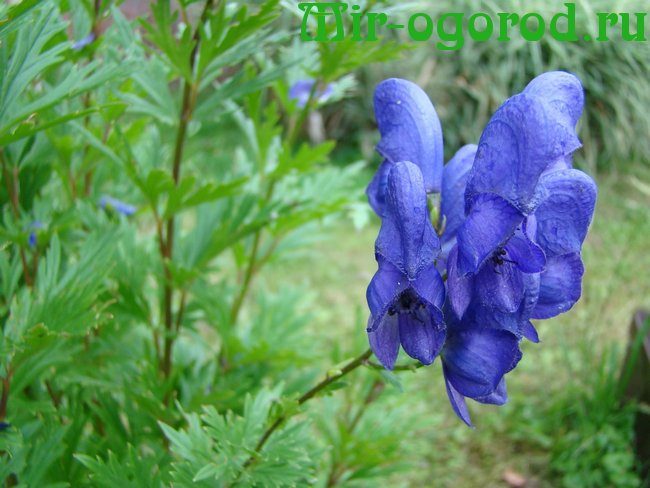

Reproduction of aconite
The plant can be propagated by seeds (varietal characteristics may not be preserved), green cuttings, tubers and dividing the bush.
The seed method of reproduction of aconite is quite time consuming and long. Seeds need stratification (cold treatment), so sowing is carried out in the ground in the fall, or aconite is sown in seedling boxes, which are stored until April in a cold place (on the balcony, in the cellar, in the refrigerator). The seeds of the wrestler are small, only 1 mm long, they are not embedded in the soil, but scattered over the surface of the earth, lightly sprinkled with sand on top. Soil for sowing aconite is suitable for store-bought universal for flowers, or you can use a mixture of peat, sand and humus, taking the components in equal parts.
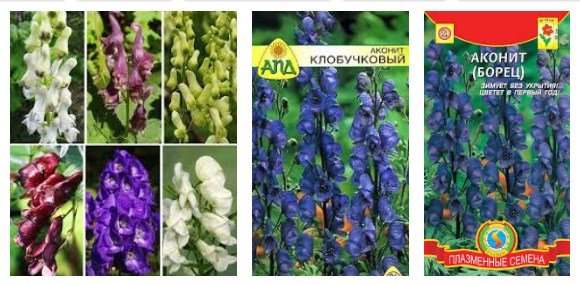

Seeds
The emerging seedlings dive into separate pots, at the age of 2 true leaves. Seedling care is usual: watering, loosening. Seedlings are placed in open ground at the end of summer, maintaining a distance between the bushes of at least 30 cm.Aconite grown from seeds will bloom in the third year.
Once every 4 years, the wrestler is recommended to rejuvenate by dividing the bush, with a transplant to a new place. It is better to do this in the spring, as soon as the greens have started to grow. The bush is dug out entirely, a part of the rhizome is cut off with a sharp shovel, along with the upper shoots. At least three apical buds should remain on each part of the rhizome. When replanting a piece of aconite to a new place, the root collar of the plant is deepened by 2 - 3 cm. After transplanting, the bush is watered abundantly. The land is mulched with peat or humus.
Important! Do not forget to work with aconite with gloves, and it is good to rinse all garden tools from poisonous juice.
At the beginning of autumn, you can plant a wrestler with tubers, dropping 2 - 3 things into one hole. Cuttings are cut in May from young green twigs.The planting material is kept in a solution of a root formation stimulator, and is stuck obliquely into the prepared bed. The plantings are shaded, and a mini-plaque is installed. Care consists in regular watering and loosening the earth. Rooted seedlings for the next year are transplanted to a permanent place. Aconite tolerates transplanting well, but it is important to freely spread the roots of the plant in the planting pit.
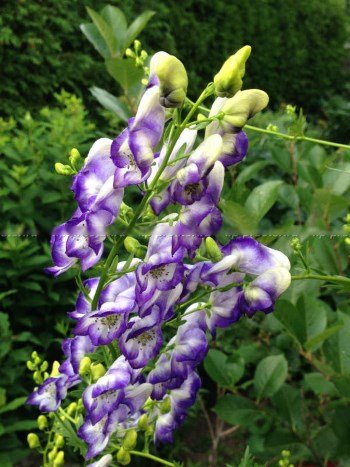

Aconite blank
In oriental medicine, Chinese aconites, palmatum and Fischer are used.
Leaves, flowers and tubers are harvested during flowering, taking precautions: the poison quickly penetrates the skin, the aconite is harvested with gloves. It is dangerous to touch the eyes and mouth during collection.
For medicinal purposes, the entire plant or rhizome with roots is used. The collection of the aboveground part of the plant must be done in June - July during the budding period, since it is at this time that the leaves and stems contain the maximum amount of alkaloids. Green succulent leaves and fresh flower clusters are subject to collection without signs of insect infestation and retaining their natural color. Tubers are harvested in autumn, at the end of October - beginning of November (by the time the aerial part dies off). At this time, the amount of alkaloids and starch in the mother tuber is minimal, and in the daughter roots it reaches its maximum. If at this moment the root is not dug up, then the embryonic buds located on the tubers begin to develop either into the stem of the next year, or into core young roots. This process takes place underground during the winter months. You can not extract the root from the ground by the stem, as it is fragile and brittle. The roots are sorted: the old, blackened, lost elasticity are thrown away, and the smallest ones are chosen from the young ones and left for reseeding. The remaining roots are cleaned of hairy processes, washed in cold running water, laid out to dry completely or cut lengthwise. They are dried in the sun or in dry, well-ventilated rooms for a week or two, periodically (at least once a week) turning and loosening so that the raw material does not get stuck. Collection and drying of raw materials in order to avoid poisoning should be done with gloves. During drying, raw materials give off an unpleasant, pungent odor. Dried raw materials can be determined by the following features: they become brittle when bent, the intensity of the smell disappears or significantly decreases in it.
Raw materials can also be dried in dryers at a temperature of 40-50 ° C. Alcohol tincture of aconite roots should be stored in a closed box, as a potent poison, with the obligatory label "YAD!" on the bottle.
Care features
The plant is unpretentious in growing in the garden. With the right choice of place and adherence to the planting technology, aconite grows rapidly and blooms profusely for a long time. Minimum care requirements are required:
- fighter is a drought-resistant plant, it is recommended to water it 1-2 times a week. During a dry period, the irrigation regime should be increased, and in case of prolonged rains, it should be reduced to a minimum. The water should be soft, settled and warmed to ambient temperature;
- during the summer, only two dressings are carried out - in early spring before the beginning of the growing season, during the flowering period. For the first time, it is advisable to add organic matter, for example, a mullein solution in a ratio of 1:12. During budding, the plant needs potassium and phosphorus, therefore it is better to use complex mineral compositions for flowering plants at the rate of 30 ml per one bush;
- it is necessary to regularly weed, as well as loosen the soil after each watering. Work should be done very carefully so as not to damage the root system. In addition, it is advisable to replenish the mulch layer, which helps to retain moisture and heat on the soil surface;
- the flower has a high resistance to diseases and pests. Preventive treatment is not required.The most dangerous for aconite are fungal infections that develop when grown in high humidity conditions. Copper-containing chemical fungicides are used as a treatment.
Aconite can grow and bloom comfortably in one place for more than 5 years. After that, it is advisable to transplant after the end of flowering in the fall. To do this, the plant is completely cut off, the rhizome is carefully dug out and transferred to a new place. For the next season, the bloom will be less bright.
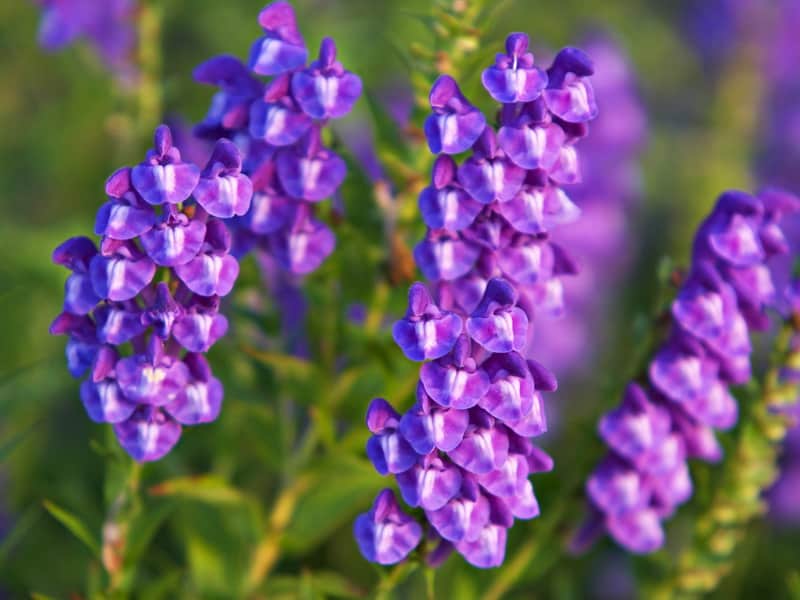

Aconite bloom
The flowering time of a plant depends on its variety. Most wrestler species bloom in mid-summer. For some, the flowering time falls in August, but there are also such varieties that adorn the site with their unusual bright flowers from mid-autumn to the first frost.
Aconite inflorescences are in the form of long, large and loose brushes of various shades: from dark blue to snow-white. There are also bicolor varieties.
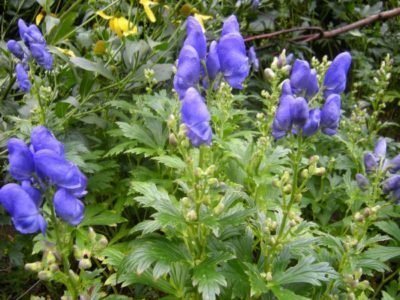

General information
Aconite is distinguished by its excellent decorative qualities not only due to its luxurious flowers, but also retains its beauty even after their flowering due to the unusual patterned leaves. The plant will complement any landscape composition and will become a real decoration of the garden plot.
It is not difficult to grow aconite, the main thing is to follow the advice of experienced gardeners, which we will share with you below.
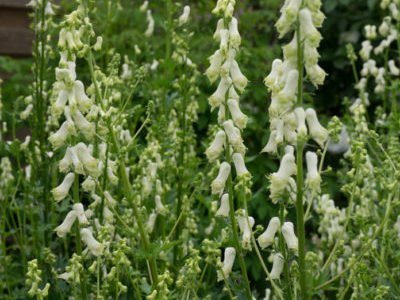

The versatile possibilities of aconite
Treatment by a fighter is due to the ability to prevent not only cancer, but also a number of other disorders. As a therapeutic purpose, not only tincture is used, but also the wrestler's capsules, which have an equally positive effect.
Treatment of diseases of the skin, mucous membranes and scalp
The use of a fighter is justified for allergies of neurotic origin - psoriasis, neurodermatitis and erysipelas. In addition, aconite is used to eliminate symptoms such as scabies and lice.
Some medical books describe the positive effects of aconite on the skin in the case of melanoma and other skin cancers.
Infectious disease therapy
The use of a fighter has been justified since ancient times to combat such infectious lesions as anthrax, plague, and leprosy. For the treatment of such pathologies, a tincture is used, which is taken not only internally, but also externally.
The action of aconite for allergies, poisoning with berries and mushrooms, bites of poisonous snakes and insects
The alkaloid contained in the wrestler acts to reduce the activity of other poisons. This ability made it possible to use drugs to eliminate the symptoms of other poisoning. In this case, the main action of aconite is associated with blocking the penetration of hazardous substances into human cells.
Use of tincture for injuries and diseases of bones and joints
The fighter's effect, which helps to eliminate inflammation, makes it possible to use the drug to relieve pain after dislocation, fracture, arthritis and osteochondrosis. Some folk recipes determine the intake of funds with a fighter against sciatica and neoplasms in the bones.
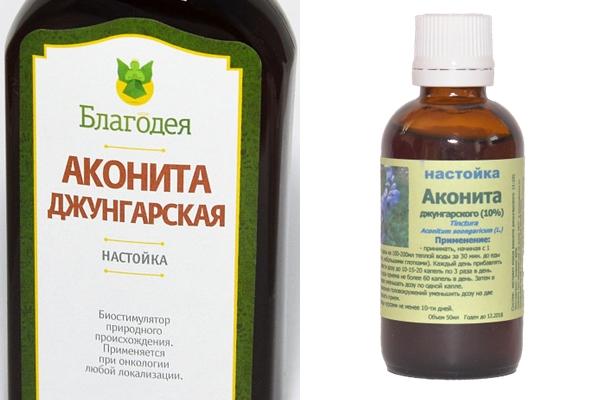

Application of aconite in neurology and psychiatry
The therapeutic effect of the wrestler's tincture is due to its high efficiency against neurological pathologies. The wrestler is used in the treatment of mental disorders such as seizures and epilepsy, neurosis and schizophrenia.
The neurological use of aconite is due to the good efficacy of the plant in the fight against migraines, dizziness, neuritis and paralysis.
Treatment of inflammatory and allergic disorders of the respiratory system
Aconite is widely used in the treatment of inflammatory pathologies of the respiratory system. Indications for the use of drugs with a fighter are pneumonia, bronchitis and tonsillitis, pleurisy in advanced stages and with their small manifestation.
Application in the treatment of disorders of the gastrointestinal tract
The ability to eliminate the inflammatory process allows the use of aconite in the treatment of pathologies such as gastritis, ulcerative formations, increased gas production and hepatitis. In addition, the wrestler has a positive effect in the fight against helminthic invasions.
Therapeutic effect of extract from aconite tubers on the cardiovascular system
The effectiveness of the treatment of arterial hypertension and angina pectoris with the help of a wrestler is due to the ability of aconite to relax the walls of blood vessels and affect the work of the heart.
Other diseases for which aconite helps
Since the wrestler is a universal remedy, its use has a positive effect on circulatory, hearing and vision disorders. There are known cases of effective use of medication with a wrestler to raise muscle tone and improve general condition.
Aconite has a positive effect on endocrine pathologies, baldness and various oncological pathologies.
Aconite in homeopathy
The widespread use of the fighter in homeopathy is due to the ability of drugs to affect cancer cells. Aconite affects oncological markers, preventing the occurrence of metastases. In addition, the poison contained in the plant blocks the growth of an existing tumor, and also prevents the secondary appearance of the focus after chemotherapy.
In the treatment of oncological disorders, aconite is used in a strictly observed dose, so side effects are rare. Regular use of aconite as a drug against oncology helps to reduce the size of the tumor. There are cases of complete resorption of the focus.
Owner reviews
Natalia N., Kryvyi Rih The wrestler is such a pretty plant. The most beautiful lilac "shoes" against the background of carved green leaves look obscenely tender! Taking care of a flower is easy. Likes to grow in high and warm places, multiplies by dividing the bush, both in spring and autumn. He needs to be fed, watered, weeded - this is all that a fighter needs for full development.
Vladimir Z., Novorossiysk
I took a spine about 3 years ago from a granny in the bazaar. I don't even remember what she called him then. Later, at the forum, they said that it was aconite. I am yellow. It grows in the shade, and I have already seated it in the sun. But in the sun, for some reason, it comes out lower as a sprout. I don't know any problems with him. The only thing is that it pesters aphids. But he is not the only one who suffers. I process Aktara together with other plants.
Zoryana S., Rostov
The wrestler has been growing in my garden for a very long time. It was also planted by our grandmother. I remember when I was a child I was strictly forbidden to approach him. I have it in two colors: white and pale lilac. When very beautiful bloom. And the flowers hold for so long. Probably more than a month. From time to time I divide it and plant it behind the fence. But not often once every 5-6 years, I guess. And, in general, it is problem-free. It grows under my old apple tree.
The poisonous properties of aconite
Humanity learned to use aconite toxins a long time ago: they smeared arrowheads and poisoned food and water, which was intended for the enemy or large predators. They say that the glorious Timur also died, poisoned by a skullcap soaked in aconite poison. Not only the organs and sap of the plant are poisonous, but even its smell: the Roman soldiers lost consciousness from it and suffered from bilious vomiting.
The cause of the toxicity of the fighter is the alkaloids included in its composition, which cause paralysis of the respiratory center in living beings, accompanied by convulsions.
- Winter rose care
The warmer the climate in which aconite grows, the more poisonous the plant is, but in cool conditions the wrestler can completely lose his dangerous property. For example, in the Scandinavian countries, cattle are fed with aconite grass. And in the middle lane, cultural aconite in fertile soil becomes completely harmless after a few seasons.


In the photo: Aconite bloom
Watering aconite
Plant care begins with proper watering. Aconite cannot be called a moisture-loving plant, he does not like waterlogging, since it is very dangerous for him.
If the summer is dry, the wrestler should be watered twice a month, making sure that the topsoil does not dry out. Also, the ground around the plant must be loosened so that air is constantly available to the root system. Do not forget to remove the weeds so that they do not "pull" the nutrients needed by the plant from the ground.
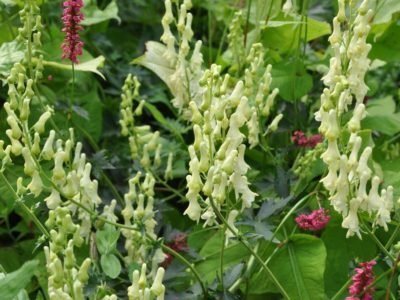

Pruning aconite
In order for the aconite bush to retain its splendor and decorative appearance, wilted inflorescences should be removed. Since the plant does not bloom for too long, pruning will give the wrestler a signal to bloom again.
To get seed, you should leave a few inflorescences without cutting them. Then you need to wait until they are fully ripe and collect the seeds.
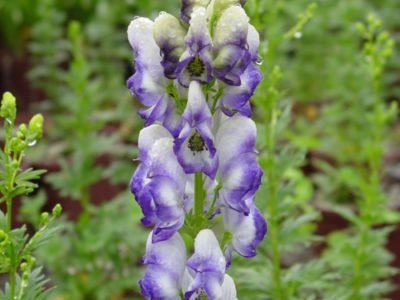

Types of aconite
Most often grown in culture:
Aconite nodule
Comes from the south or from the center of Europe. It reaches a height of 130 cm, its straight shoots form a pyramidal bush that grows up to 70 cm in diameter; glossy, dense, five- or seven-partite leaves are painted in dark green, and bluish-white or dark blue flowers with a diameter of 4-5 cm form a long brush. Popular varieties: Eleanor (white flowers with a red border), Rubellum (pinkish flowers), Album (creamy flowers), Newry Blue (deep blue inflorescences) and Carneum (pinkish-beige flowers).
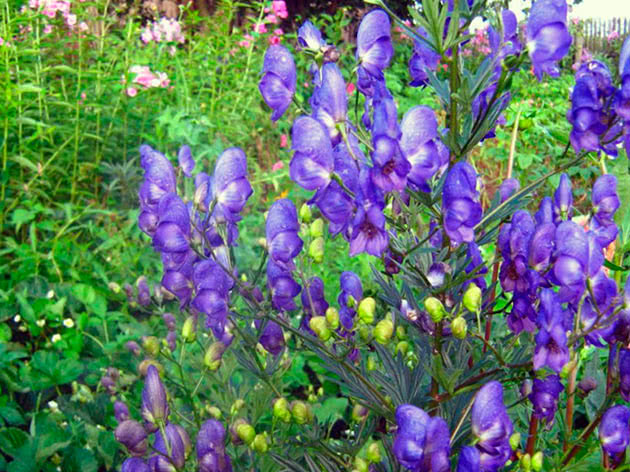

In the photo: Aconite in the garden
Aconite high
Perennial with straight, grooved and powerful shoots up to two meters high, large leaves, consisting of five or seven diamond-shaped unequal lobes and large clusters of dusty purple flowers. The most attractive is the early-flowering Ivorine variety, reaching a height of about 60 cm: it has creamy flowers and attractive foliage.
Fisher's Aconite
Grows in the Far East. In height, its bare, straight and round in cross-section shoots reach one and a half meters. The leaves consist of 5-6 leathery leaves, and the inflorescence of Fischer's wrestler is a cluster of white or blue flowers. The most famous variety is the blue-flowered Azure Monkshood.
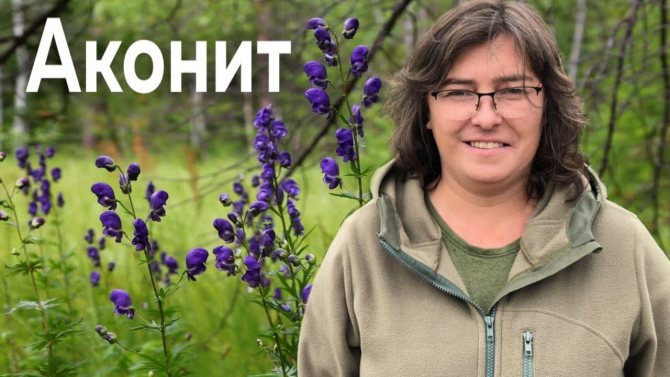

Preparing for landing
A month before planting, you should carefully dig up the flower bed to the depth of a shovel bayonet, remove stones and plant debris. Apply fertilizer, for example, cow dung at the rate of 5 kg / m2. On depleted soils, it is advisable to additionally use a mixture of mineral compositions.
Sowing seeds in the open ground in autumn avoids self-stratification, since they go through this process on their own under the soil layer. Before starting work, it is enough to sort them out, and then treat them with a 1% solution of potassium permanganate for disinfection.
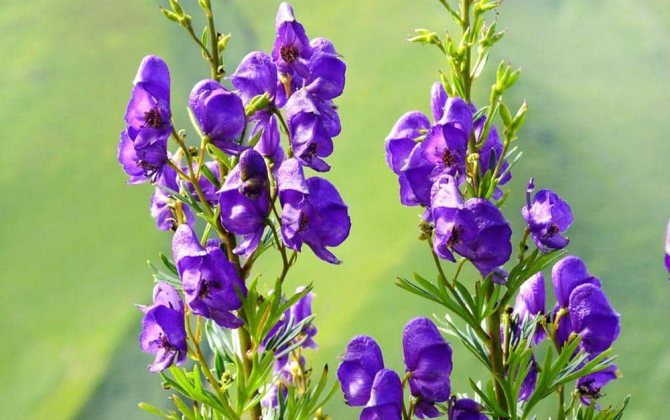

Symptoms of poisoning with aconite alkaloids
The clinical picture of aconite poisoning appears within a couple of hours after the toxin enters the human body. First, a person develops symptoms of arousal, which are abruptly replaced by depression of consciousness. Poisoning symptoms are:
- Great agitation;
- Profuse salivation;
- Fear of light and disorientation in space;
- Tingling and itching of the skin;
- Redness of the skin, the appearance of a small-point rash on the body;
- Sensitivity disorders, pallor of the skin and blue discoloration;
- Disruption of the digestive tract - burning, pain, heaviness in the esophagus and stomach, vomiting, diarrhea;
- Pain in the region of the heart;
- Arrhythmia, characterized by periodic fading of the pulsation;
- Breathing disorder.
Against the background of the manifested symptoms, the victim has a fear of death and disruptions during urination. In some cases, there is a complete lack of urination. Disruption of the heart and nervous system leads to the death of a person.
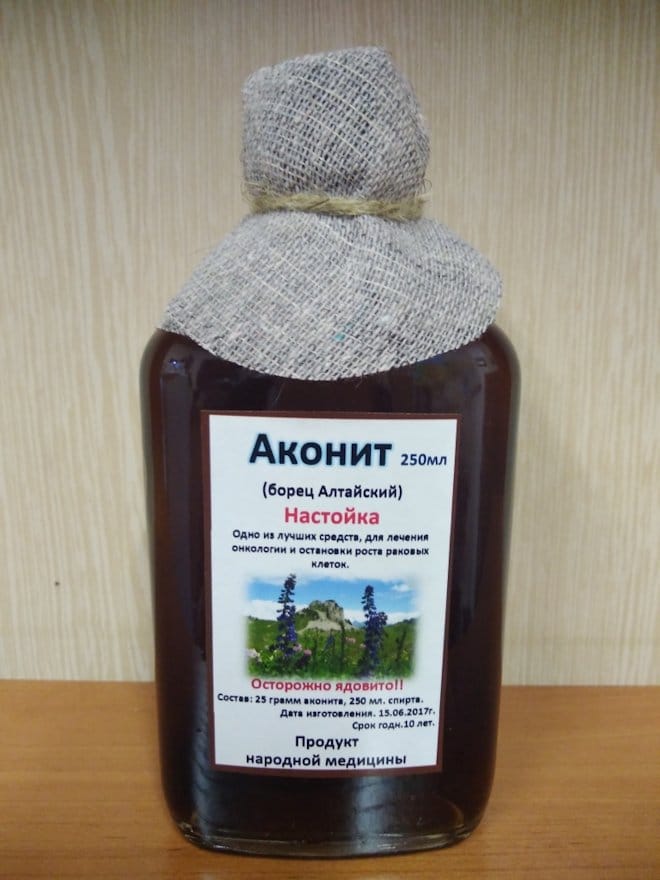

Can poison be a cure
When a substance enters the body, it affects not only healthy cells, but also cancer cells.The therapeutic effect of aconite is based on the fact that after the absorption of the active substance, doctors can control the treatment process. Since the poison first blocks the work of the affected cells, under the supervision of specialists, it is possible to prevent the penetration of large amounts of poison into healthy tissues.
Tincture of aconite against cancer and adenoma: preparation and use
Treatment of oncological ailments using aconite requires not only correct preparation of roots and adherence to dosages, but also a clearly established duration of the course of taking the drug. Since aconite is a very poisonous and aggressive plant, it destroys not only cancer cells, but also healthy ones.
However, despite this, tinctures based on it in folk medicine are used for many oncological diseases, allowing the patient to recover even when traditional medicine has put an end to him.
In cancer, it is the tinctures of aconite root that are most often used. The preparation of several of them will be described below.
Tincture of aconite for cancer
To prepare the tincture, take 50 grams of aconite rhizome, peel and grind it. Then pour them into a jar and pour 500 milliliters of 40% alcohol. After that, the jar should be covered with a lid and stored in a dark place for two weeks.
You need to take the finished tincture in ascending order. On the first day, one drop is drunk, on the second day - two drops, and so on, increasing until the eleventh day. On the eleventh day, eleven drops should be consumed, diluted in half a glass of water.
Then, starting from the eleventh day, the intake of the tincture should be reduced by a drop with each new intake, until the patient reaches one drop with which he began. To get rid of the disease, you should go through three to six courses, taking a month break between them.
Tincture of aconite for adenoma
To prepare the tincture, take 3 grams of the dry rhizome of the plant, place it in a jar, pour in 100 milliliters of vodka, cover and put in a dark place for 14 days. The remedy should be taken according to the scheme 1-20-1. First, the number of drops drunk should be increased daily to twenty, and then, when the patient reaches this value, it is necessary to begin to reduce them daily, reducing to one.
When using tinctures in the presence of cancer, you should first consult your doctor.
As you can see, aconite is not only a beautiful plant with decorative properties, but also a home assistant in the treatment of many diseases, so if you decide to grow it in your garden, you will definitely win.
Site selection for aconite
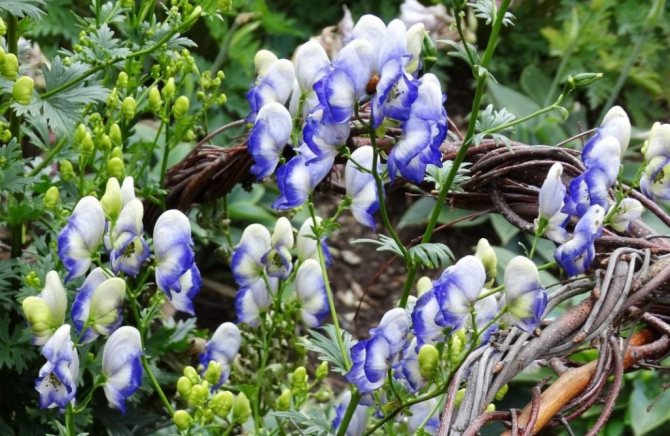

This grass does not like direct sunlight, which will appeal to many lovers of a shady garden. Only two varieties - Karmichela and Antorri prefer sun-drenched areas. Most types of aconite love partial shade and shaded areas. To ensure your aconite is properly cared for, plant it in the northern part of your garden. Planting aconite is preferable in partial shade.
If you are planting climbing varieties, then choose a shady, cool place for planting. This unpretentious perennial absolutely cannot stand the scorching sun and may die.
The wrestler grows especially well on substrates, but except for sandy ones, in which there is a lack of moisture and gravelly. But more abundant flowering can be achieved if aconite is planted on soil rich in organic matter and moisture.
When choosing a site for planting, give preference to a place where water does not stagnate in the fall - excessive moisture in the fall can lead to decay of the roots and death of the plant. Correct landing is the key to successful wrestler rearing.
Aconite transplant
Usually, the transplant is carried out in the spring, having previously prepared a new site for planting the plant. However, some growers spend it in the fall.Before proceeding with the transplant, the garden soil should be dug up, adding peat and compost to it. It is best to transfer a plant from an "old" habitat with a lump of earth so as not to damage the root system.
At the bottom of the planting pit, a drainage layer of expanded clay should be formed. The pit should be slightly larger in size than the soil with which the plant was transferred. When moving the aconite into a new pit, it is necessary to pour a little mineral fertilizing on top of the drainage, according to the instructions on the package.
Then you should place the bush in a hole and sprinkle it with prepared soil, after which it must be tamped, mulched and watered abundantly. Adaptation to a new place in aconite can last from 1 to 1.5 months. At this time, it must be carefully cared for.
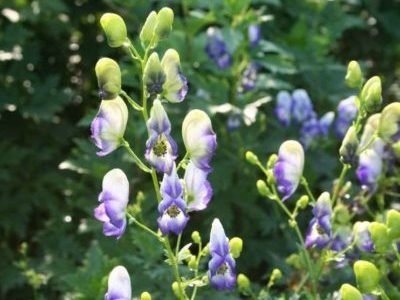

Possible growing difficulties
With the wrong approach to plant care, growers may face problems such as:
- Lack of flowering - the reason for this condition is often an insufficient amount of water in the soil. In addition, the flower stops blooming if the soil contains few nutrients or air.
- Late flowering - the reason for this phenomenon is the low air temperature or the characteristics of the variety. In the first case, the solution to the problem comes with an improvement in climatic conditions, in the second - the problem simply does not exist, these are the characteristics of the variety.
Growing a wrestler in a garden does not require special efforts from the grower and creating conditions. However, any plant needs care, which determines the duration of flowering and the beauty of the shrub.
Reproduction methods
The wrestler can be propagated by almost any vegetative means. Common methods:
- Seeds. The planting material is harvested after flowering, after which it must be dried. It is necessary to plant seeds the next year, since they quickly lose their germination;
- Division of the bush. Aconite from 3 years old is suitable as a mother plant. The plant needs to be dug up, the soil on the root system must be cleaned. Divide the bush with a knife or shovel into 2-3 parts, plant each plant in a new place. Work should be carried out only in the fall;
- Cuttings. In early spring, before the bud swells, a healthy and strong shoot should be separated from 2 years of dew. The optimum length of the cutting is 10-12 cm. Treat the cut site with charcoal, place in a container with a nutrient substrate, but rooting is also possible in water. It is better to transplant to the main place at the end of the season for the winter.
It is advisable to propagate aconite by dividing the bush. This is the easiest and most effective way to get a new plant; it is convenient to combine the procedure with the next flower transplant.
Aconite or wrestler is a spectacular tall perennial that can decorate any flower garden. The article describes aconite, planting and caring for it in the open field. We will consider the main features of growing a crop, as well as the rules for its application in landscape design. The text is illustrated with vivid photos of various varieties of aconite.
Historical excursion
The history of the genus name is not known for certain. There are at least two variants of origin: from the word meaning in Greek “cliff”, “rock”, and from the word that is translated as “arrow”. And there is also a mythical explanation for the name: completing his next feat, Hercules brought out the three-headed dog Cerberus from Hades, and he, breaking free, spattered everything around with his poisonous saliva; in those places where the drops fell to the ground, tall and through and through poisonous plants rapidly rose, which they called aconites, since everything happened near the city of Akoni. And aconite was called a fighter in accordance with the Scandinavian legend: he allegedly grew up in the place where Thor, who fought the poisonous reptile, died from her bites.
What does aconite look like
Perennialwhich is often considered poisonous.
Differs in flowers in the shape of a helmet. There are different colors. Single stems hold flowers that tend to gather in clusters. The composition is framed by rounded leaves with split edges. Sometimes aconite is curly.
Types of aconite
About fifty species of Aconite grow on the territory of Russia. They are divided into three subspecies.
- In the first, the most poisonous varieties. They have blue flowers and more than two tubers.
- The second category includes less dangerous plants: aconite purple, yellow, white.
- The third group contains non-toxic yellow aconites.
Aconite fighter is not whimsical to lighting and soil. The aconite plant is resistant to cold weather and enjoys almost any feeding. The soil should be mulched with peat about three times a season. It grows for about five years without a transplant.
Dzhungarian Aconite
It is found in the mountains, where moist soil prevails, near the shores of mountain reservoirs. Feels comfortable in the forest, subalpine and alpine zones above the sea.


Dzhungarian aconite has a horizontal rhizome, where cone-shaped tubers have grown together into a chain.
- The plant has a dense stem that can reach 130 centimeters in height.
- The leaf of the plant is heart-shaped with rounded edges. Stretched out in width. It is divided into five sectors, each of which is divided into 2-3 more segments.
- The flowers are collected in an inflorescence, where the sepal is bent from above in an arc in the form of a helmet. About forty stamens, three pistils.
- The fruit is considered a shamrock. It happens that only one leaflet ripens. The seed is about 5 mm long. Ripen in late summer, early autumn. Tubers are used in medicine.
Karakol fighter
This aconite is similar to the previous one. There is a version that Karakol is a kind of Dzhungar aconite. Different plant heights. The second reaches two meters. And the sectors of the sheet are narrower. The flower is not as large as that of a fellow. But the color is bright purple.
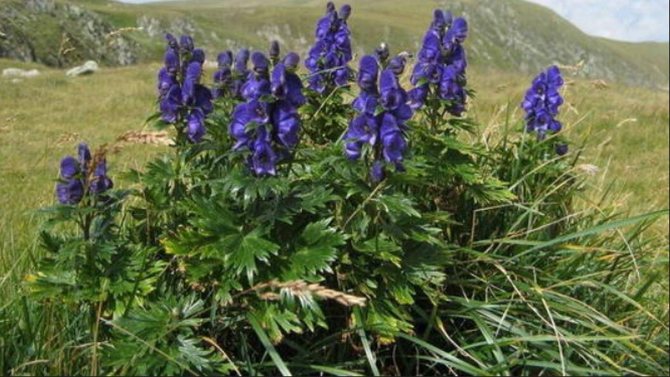

Often these species grow intermixed. If you stumble upon a mixture of aconites, you are unlikely to understand the differences. Karakolskiy comfortably exists in meadows and near rivers.
Propagated by seeds and rhizomes. Young aconites have one stem. The number grows with age. They all come from the same root. Maximum 4 pieces. Each has about six dozen seeds.
Wrestler yellow
- Aconite is a perennial herb. A tough root like a turnip.
- The sheets are protruding in different directions, diamond-shaped, with a ribbed edge.
- The inflorescence is fluffy, but small.
- Sepal in the form of petals. The top one looks like a bell. Aconite curly. Eight petals, a pair of upper ones curled.
- Aconite is white and yellow. The middle is often blue. Aconite seeds have a triangular and wrinkled texture. Bloom from the second summer month to early autumn.


Occurs in the forest and near bushes. There are many representatives of yellow aconite in the mountains of Central Europe and Siberia. It is a poisonous flower variety.
The root is used to poison dangerous animals for the purpose of protection. Its properties are similar to blue aconite.
Aconite blue
Can be seen in groves and gardens. It often grows along the fence. Perennial and herbaceous species.
- The stem is straight, almost one and a half meters high.
- Blue aconite has a smooth leaf. Green on top, white on the back. It is similar in shape to a wedge.
- The many-headed aconite root, 3 centimeters thick, hides deep underground.
- Despite the name, the flowers are not only blue. There are white aconite and violet aconite. The structure is the same as yellow.
- The fruit is three leaflets. The seed is dark brown, triangular.
- Blooms throughout the summer season. Its leaves taste bitter. After a while, the tongue and palate are covered with a burning sensation.
Attention! Blue aconite is poisonous. If you rub the leaf, the smell will make you dizzy. Do not apply to the body, otherwise blisters and wounds will appear.


Northern or tall wrestler
Like the previous species, it is a perennial herb.
- A wrestler older than two years in the flowering phase has a vertical root with thin appendages.
- The stem is straight, two meters high.
- Ribbed to the touch, drooping with leaf petioles and pedicels.
- The leaves are rounded, closer to the heart-shaped, dense. Cut into diamond-shaped sectors. Some are covered with barely noticeable fine hairs.
- The inflorescence is long, almost half a meter. At the same time, it is rare.
- Aconite flowers are purple and dirty. The middle is almost white.


The northern wrestler loves moist soil and freshness. It is found in forests, meadows, coastal areas of rivers and in the mountains.
Aconite bicolor
A two-color species of the aconite plant. Inflorescences are high, like brushes. The flowers are blue and white. One and a half meters in height, the length of the stem. Lozenge-shaped sheets with green color. The flowering phase occurs in mid-summer. Aconite seeds show by autumn.


The healing properties and use of Aconite
The aconite flower is found all over the planet, has long been known to mankind. With the help of a fighter, arrow poison was obtained. That is, people hunted animals using a similar means. But even after the poisoning, the game was suitable for human consumption.
It is no secret that aconite contains medical properties. But the stigma of the poisonous plant did not allow it to become known as a healing one for a long time. In the first half of the 19th century, a French chemist Peschier introduced alkaloids to the world. Then the use of aconite in medicine spread.
In Russia, treatment with aconite is not used. Earlier, tincture of Karakol and Dzhungar aconite went for anesthetic for sciatica and neuralgia. Applied externally.
Today aconite is an officially recognized medicine in Bulgaria, India, China and partly in western Europe.
- They are used to help with a wide variety of health problems. In Tibetan medicine, the aconite wrestler is highly valued. They are used to treat malignant tumors, inflammation and infection of the gastrointestinal tract.
- They fight diabetes, epilepsy, syphilis, paralysis, cardiovascular ailments.
- Scientists report that in Kyrgyzstan and Kazakhstan, aconite relieves headaches in people, gives strength to the elderly population, treats sciatica, tuberculosis.
- In Siberia, the plant is used to treat wounds and to treat fractures.
Now the species is being explored blue colored aconites... It is believed to be a promising drug as it affects every part of the body.
This means that it is able to normalize the endocrine, immune, nervous, cardiovascular systems.
It is important to note yellow wrestler... It is noteworthy that its root is not poisonous. Despite this, this type of aconite contains two alkaloids - anthorine and pseudoantorin. There is no doubt that this aconite contains medicinal properties.
- The overground half of aconite helps against toxicity, impotence, and nervous ailments.
- Treats paralysis and stomach problems.
- In the south of Russia, it is used as a cure for gastritis and ulcers.
It is believed that the wrestler beats the tumor. But the fact is not proven by science. The arguments are based on the experience of Eastern countries, Europe and traditional treatments in Russia.
Contraindications
Aconite treatment is prohibited for those who suffer from allergies, hypertensive patients, pregnant women, lactating women and children.
Because of the poison in aconite, it is important not to overdo it. It is advisable to be treated under the supervision of a physician. Carelessness can lead to death.
Blooming Aconite
How long the plant will be in the flowering phase depends on the variety. Many varieties show flowers in the middle of the warm season. Some begin to bloom only in the third month of summer.
There are also those that flaunt from September to cold weather. Aconite inflorescences look like a large raceme, stretching in length.
The colors are very different. There are even mixes of shades.


Agrotechnics
The agrotechnology of growing this crop is quite simple. Aconite flower perennial cultivation and care:
- ¾ the plant is watered without fanaticism, since excess moisture harms the root system;
- ¾ after watering, the soil is loosened, grown weeds are removed;
- ¾ twice a season, the soil is mulched with a layer of peat or compost.
Top dressing is not necessary, but it will come in handy on scarce land. It is better to apply top dressing before flowering, in early spring, organic and mineral.
Aconite is not picky about the choice of neighbors, it gets along well with peonies, irises, rudbeckia, aquilegia. Moreover, from these flowers you can create an incredible beauty of the composition.
Bloom
There are often cases when there are no flowers at all on aconite, and only a green mass grows. So why doesn't aconite bloom? Perhaps the reasons are in an incorrectly selected territorial location (climate, soil, humidity), care (excessive or insufficient watering, overfeeding, or, conversely, a deficiency of nutrients, improper pruning) or damage to the plant by diseases or parasites. Perhaps the tree is not yet ripe - on average, the plant begins to bloom for 2-3 years. Late flowering may be associated with cold summers.
To prevent such a problem, it is necessary to properly care for the plant.
Plant care in autumn
Growing a perennial aconite flower in autumn means preparing for wintering, for this, after flowering, the plant is cut shortly, the rhizome is covered with a 15-20 cm layer of peat or more to completely cover the remaining stems. This shelter will be sufficient, since most varieties have high frost resistance.
Interesting fact. Aconite lady's shoe by the fall, one might say, dies almost completely, only vegetative buds, located at the very base of the shoot, function, thanks to which a new stem is released from the flower in the spring and is covered with lush flowers.
Aconite is unpretentious in care and cultivation; it does not require any special skills from a gardener. You can grow absolutely any variety both in the garden and in the house, the main thing is to take into account the conditions necessary for a flower. In response, the "poisonous household" will delight with beautiful and lush flowers, and will bring medicinal benefits.

